文章目录
一、MyBaties介绍
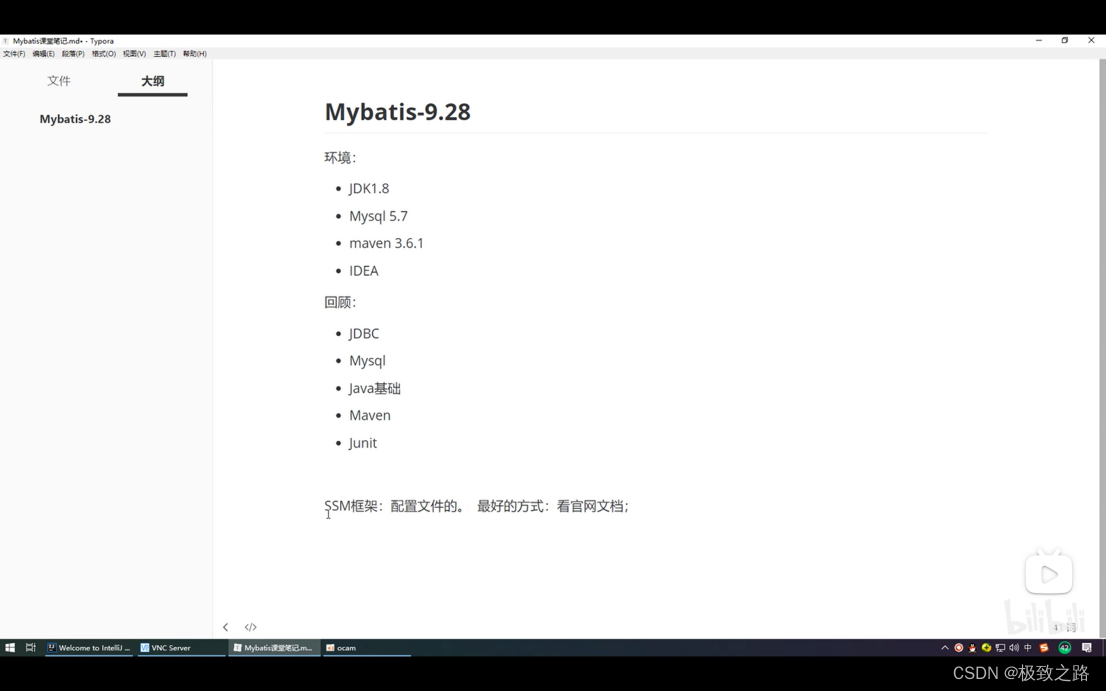
最好的学习方式:看官网文档。
(1)什么是MyBaties?
- MyBatis 是一款优秀的持久层框架。
- 它支持定制化 SQL、存储过程以及高级映射。
- MyBatis 避免了几乎所有的 JDBC 代码和手动设置参数以及获取结果集。
- MyBatis 可以使用简单的 XML 或注解来配置和映射原生信息,将接口和 Java 的 POJO映射成数据库中的记录。
- MyBatis 本是apache的一个开源项目iBatis, 2010年这个项目由apache software
foundation迁移到了google code,并且改名为MyBatis
折叠
(2)maven的引入
引入依赖包:
<dependency>
<groupId>org.mybatis</groupId>
<artifactId>mybatis</artifactId>
<version>3.5.11</version>
</dependency>
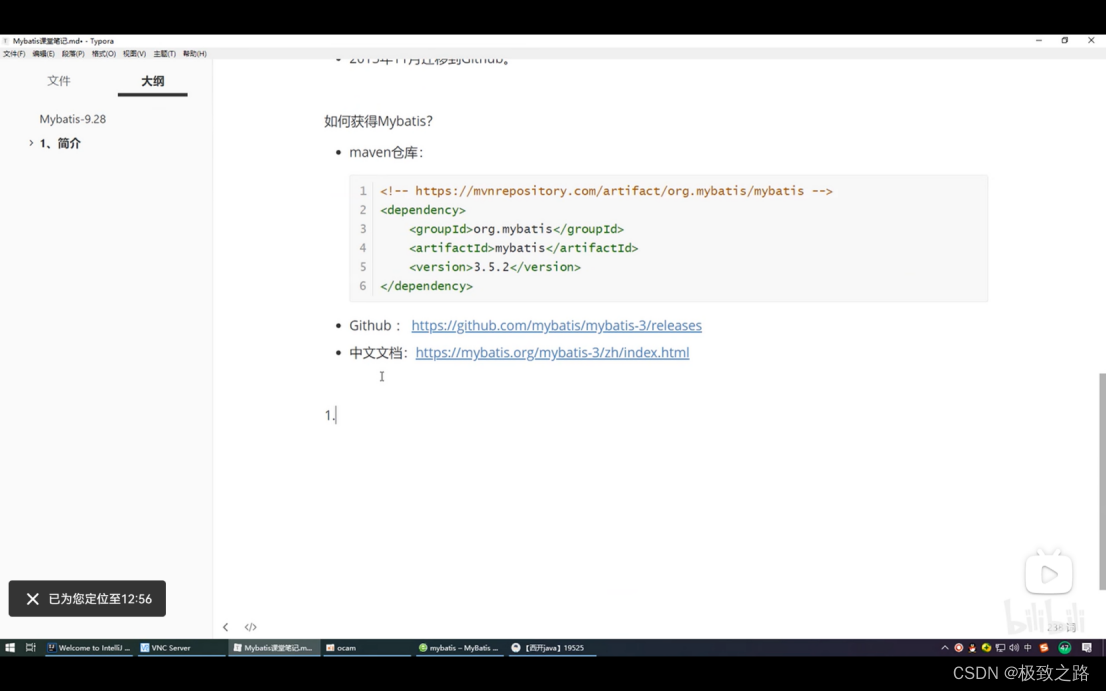
3种方式都可以。
(3)持久化和持久层
- 数据持久化:
- 持久化就是将程序数据在瞬时状态和持久状态转化的过程。
- 内存:断电即失。
- 持久化实例:数据库(jdbc),IO文件持久化。冰箱冷藏。
- 为什么需要持久化:
- 有些对象,不能让它丢掉。
- 内存太贵!
- 持久层:
- Dao层,Service层,Controller层…
- 持久化是一个动作,持久层是一个概念,表示完成持久化工作的代码块。 层界限非常敏感。
(4)为什么需要MyBaties?(好处)
- 框架:自动化操作。
- 传统的JDBCD代码太复杂了,框架可以简化这个过程。
在myBaties框架中,sql是写在配置文件里的,都不用写在java代码里。做到了sql和代码的分离。
(5)github中下载的步骤
在github中搜索mybatis:
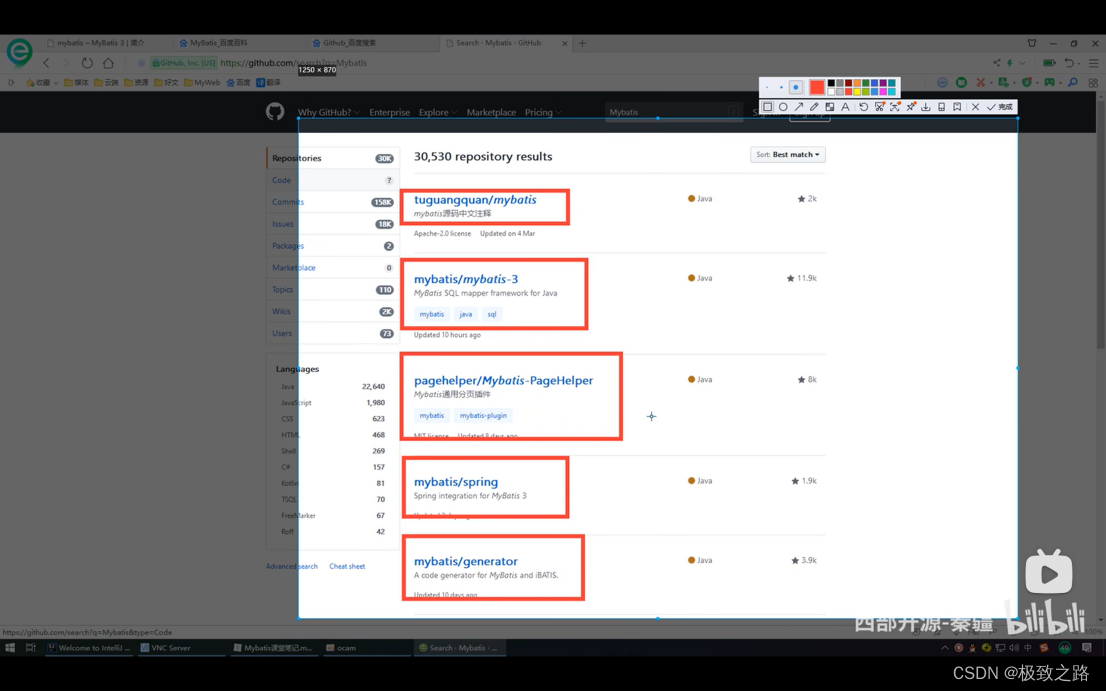
第二个mybaties本身。

点击Releases:
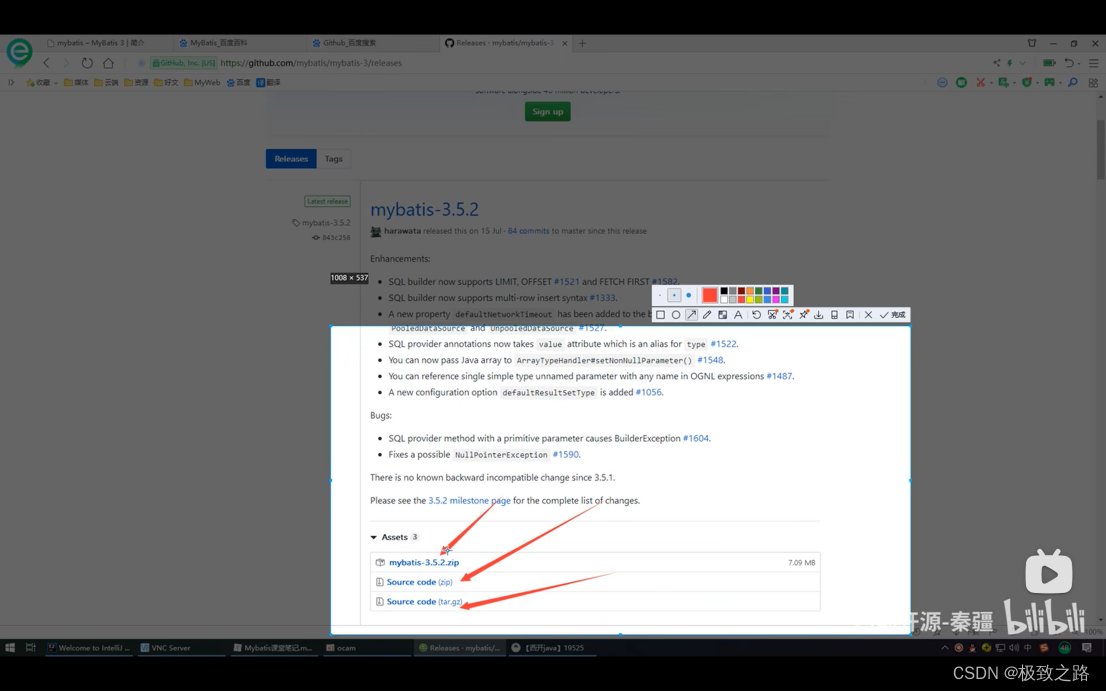
压缩包可以直接下载,下载下来就是它的jar包。
二、第一个Mybatis程序
思路:搭建环境->导入MyBatis->编写代码->测试。
(学习一个新东西,任何东西按照这个逻辑来,不会有任何问题。)
(1)搭建环境
1.1 创建数据库和表
新建myBatis数据库,创建user表并添加数据。
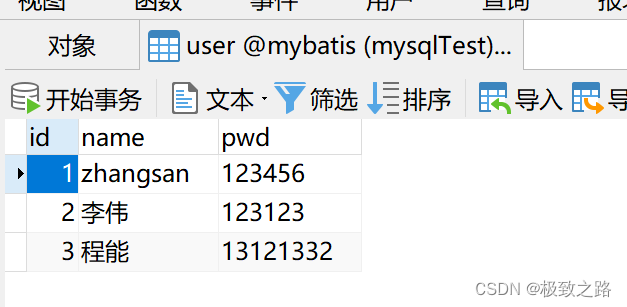
1.2 新建项目
- 1.创建一个普通的maven项目
- 2.删除src目录
- 3.导入maven依赖:
<!--导入依赖-->
<dependencies>
<!-- mysql驱动-->
<dependency>
<groupId>mysql</groupId>
<artifactId>mysql-connector-java</artifactId>
<version>5.1.47</version>
</dependency>
<!-- mybatis-->
<dependency>
<groupId>org.mybatis</groupId>
<artifactId>mybatis</artifactId>
<version>3.5.2</version>
</dependency>
<!-- junit-->
<dependency>
<groupId>junit</groupId>
<artifactId>junit</artifactId>
<version>4.12</version>
<scope>test</scope>
</dependency>
</dependencies>
- 4.在该项目下 新建一个模块(新建一个maven子项目)
这样创建的好处是子项目不用每次都去导包了。
(2)导入Mybatis
2.1编写mybatis的核心配置文件:

名字为mybatis-config.xml (名字不能错):
<?xml version="1.0" encoding="UTF-8" ?>
<!DOCTYPE configuration
PUBLIC "-//mybatis.org//DTD Config 3.0//EN"
"http://mybatis.org/dtd/mybatis-3-config.dtd">
<!--configuration核心配置文件-->
<configuration>
<!-- Environments:多套环境,default可以选择其中一个环境作为默认的环境。-->
<environments default="development">
<environment id="development">
<transactionManager type="JDBC"/>
<dataSource type="POOLED">
<property name="driver" value="com.mysql.jdbc.Driver"/>
<!-- 在xml文件中,&不能用,需要转义&。-->
<property name="url" value="jdbc:mysql://localhost:3306/mybatis?useSSL=true&useUnicode=true&characterEncoding=UTF-8"/>
<property name="username" value="root"/>
<property name="password" value="123456"/>
</dataSource>
</environment>
</environments>
<mappers>
<!-- 注册xxxMapper.xml文件, 路径以/代替.-->
<mapper resource="com/kuang/dao/UserMapper.xml"/>
</mappers>
</configuration>
2.2编写mybatis工具类MybatisUtils :
package com.kuang.utils;
import org.apache.ibatis.io.Resources;
import org.apache.ibatis.session.SqlSession;
import org.apache.ibatis.session.SqlSessionFactory;
import org.apache.ibatis.session.SqlSessionFactoryBuilder;
import java.io.IOException;
import java.io.InputStream;
//sqlSessionFactory--->sqlSession
public class MybatisUtils {
private static SqlSessionFactory sqlSessionFactory;
static {
// mybatis第一步: 使用mybatis获取sqlSessionFactory对象
try {
String resource = "mybatis-config.xml";
InputStream inputStream = Resources.getResourceAsStream(resource);
sqlSessionFactory = new SqlSessionFactoryBuilder().build(inputStream);
} catch (IOException e) {
e.printStackTrace();
}
}
// 既然有了 SqlSessionFactory,顾名思义,我们可以从中获得 SqlSession 的实例。
// SqlSession 提供了在数据库执行 SQL 命令所需的所有方法
public static SqlSession getSqlSession(){
return sqlSessionFactory.openSession();
}
}
(3)编写代码
1.实体类User
package com.kuang.pojo;
public class User {
private int id;
private String name;
private String pwd;
public User() {
}
public User(int id, String name, String pwd) {
this.id = id;
this.name = name;
this.pwd = pwd;
}
public int getId() {
return id;
}
public void setId(int id) {
this.id = id;
}
public String getName() {
return name;
}
public void setName(String name) {
this.name = name;
}
public String getPwd() {
return pwd;
}
public void setPwd(String pwd) {
this.pwd = pwd;
}
@Override
public String toString() {
return "User{" +
"id=" + id +
", name='" + name + '\'' +
", pwd='" + pwd + '\'' +
'}';
}
}
2.Dao接口:
import com.kuang.pojo.User;
import java.util.List;
public interface UserDao {
List<User> getUserList();
}
3.接口的实现类/对应的Mapper.xml文件:
(接口实现类由原来的UserDaolmpl转变为Mapper配置文件)
<?xml version="1.0" encoding="UTF-8" ?>
<!DOCTYPE mapper
PUBLIC "-//mybatis.org//DTD Mapper 3.0//EN"
"http://mybatis.org/dtd/mybatis-3-mapper.dtd">
<!-- namespace=绑定一个Dao/Mapper接口,实现原理就相当于Dao对应的Impl实现了这个接口-->
<mapper namespace="com.kuang.dao.UserDao">
<!-- select查询语句,ID对应接口中的方法名-->
<select id="getUserList" resultType="com.kuang.pojo.User">
<!--sql语句写在配置文件里面。-->
select * from mybatis.user;
</select>
</mapper>
(4)测试
import com.kuang.pojo.User;
import com.kuang.utils.MybatisUtils;
import org.apache.ibatis.session.SqlSession;
import org.junit.Test;
import java.util.List;
public class UserDaoTest {
@Test
public void test(){
// 第一步:获取sqlSession对象
SqlSession sqlSession = MybatisUtils.getSqlSession();
//方式一:getMapper
UserDao userDao = sqlSession.getMapper(UserDao.class);
List<User> userList = userDao.getUserList();
//方式二:
// List<User> userList = sqlSession.selectList("com.kuang.dao.UserDao.getUserList");
for (User user : userList) {
System.out.println(user);
}
//关闭操作非常重要。
sqlSession.close();
}
}
方式二已经过时了。不用掌握,但是需要知道它存在。
第一种方式,通过mapper直接获取它的类,就可以调用类中的方法了。
方式二会根据方法的返回值去返回。
(5)可能出现的异常
初始化失败异常。
资源导出问题。无法找出.xml文件。
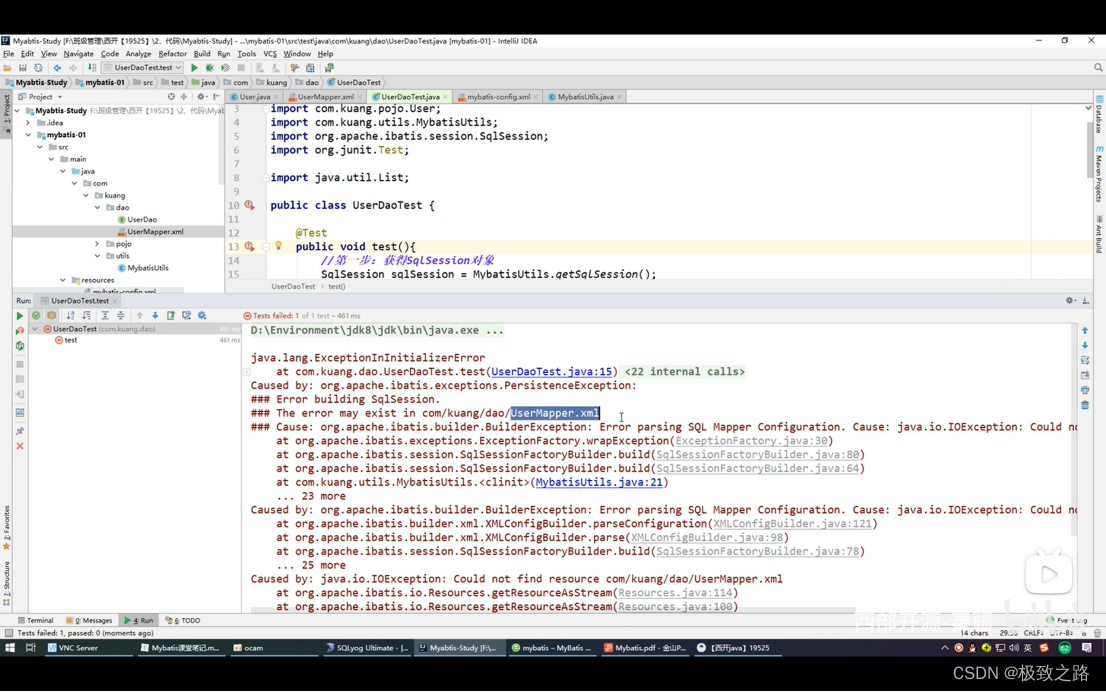
<build>
<resources>
<resource>
<directory>src/main/java</directory>
<includes>
<include>**/*.properties</include>
<include>**/*.xml</include>
</includes>
<filtering>false</filtering>
</resource>
</resources>
</build>
2.xxxMapper.xml配置文件没有注册:
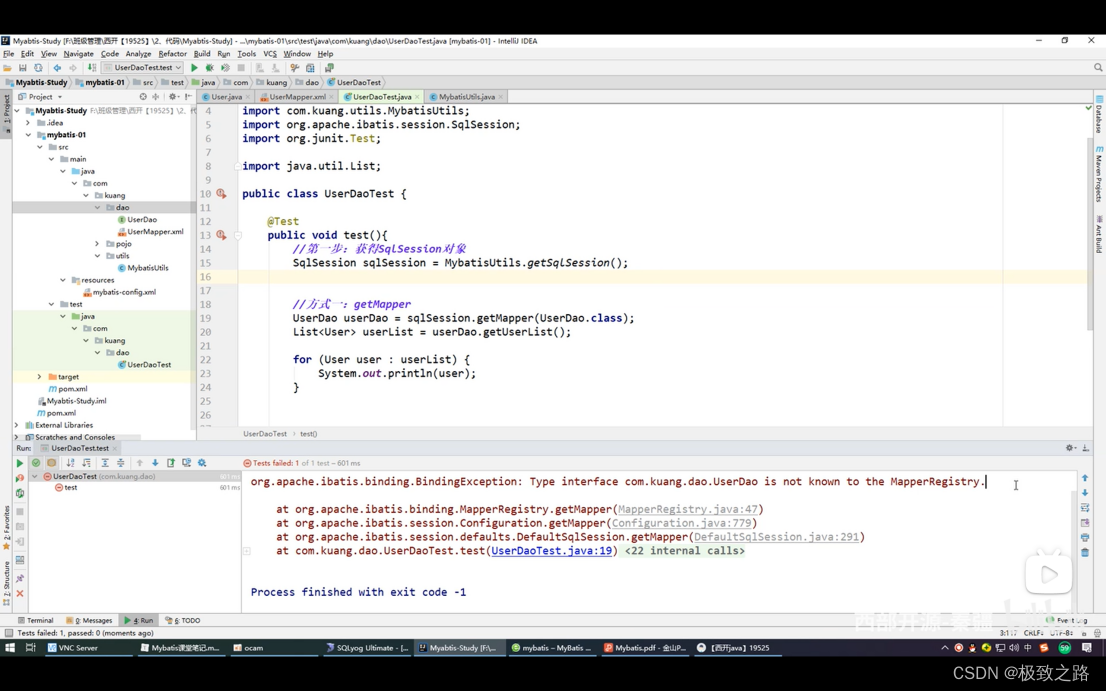
<mappers>
<!-- 路径以/代替.-->
<mapper resource="com/kuang/dao/UserMapper.xml"/>
</mappers>
3.常见问题:
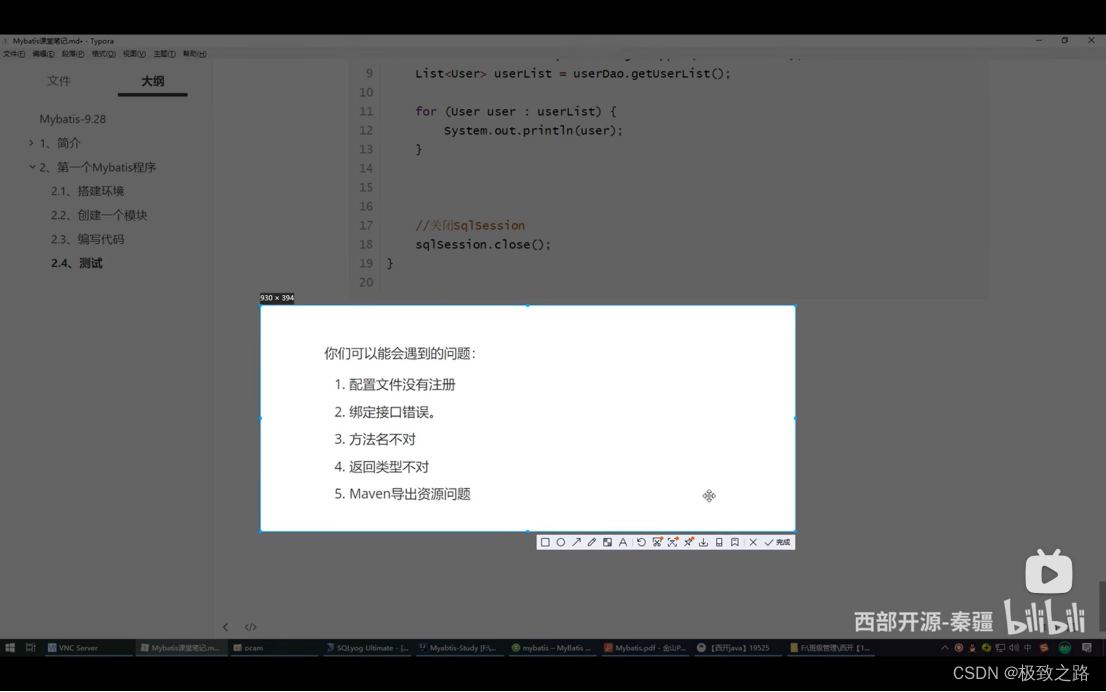
(6)注意事项
1.xxxMapper.xml文件和实现类的比较:
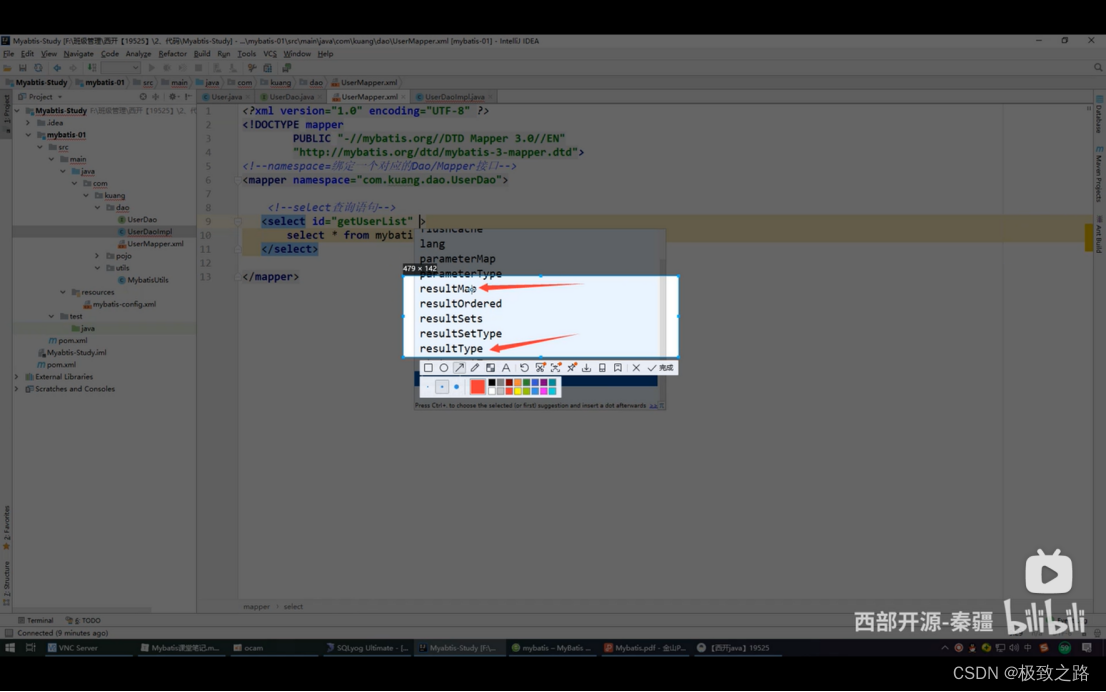
- 只需记住这两个,type表示类型,map表示集合。即前者可以返回一个,后者可以返回多个。一般都是用ResultType。
- 返回结果要用完全限定名(全类名),因为配置文件不像java类能够去找它的关联。
- 所有的集合都只需要写集合里面泛型中的东西。
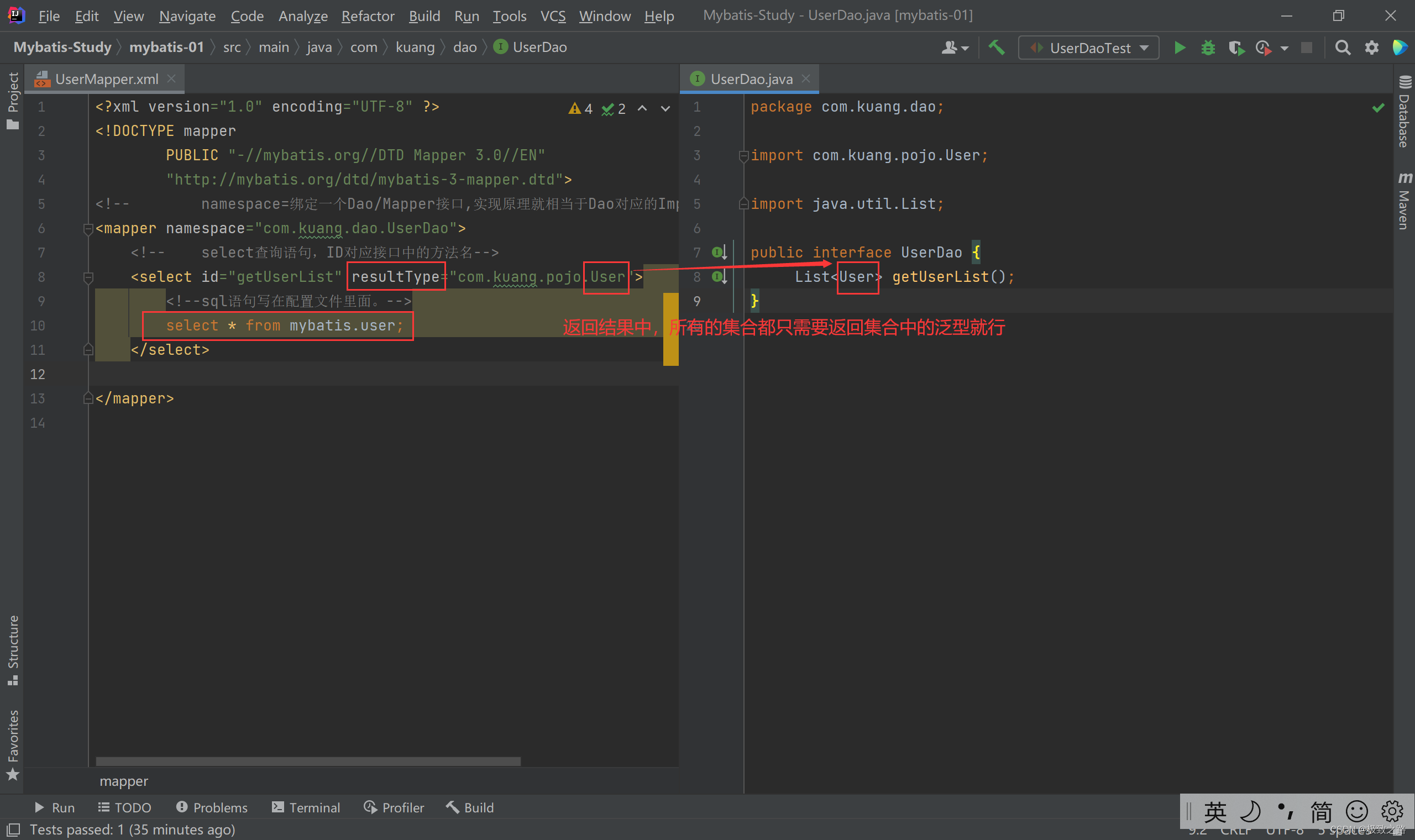
- 原来实现接口需要重写接口的方法,现在写一个标签指向要重写的方法就可以了。
- 原来要执行sql还需要连接数据库等jdbc的语句,现在在xml中只用执行sql就可以了。
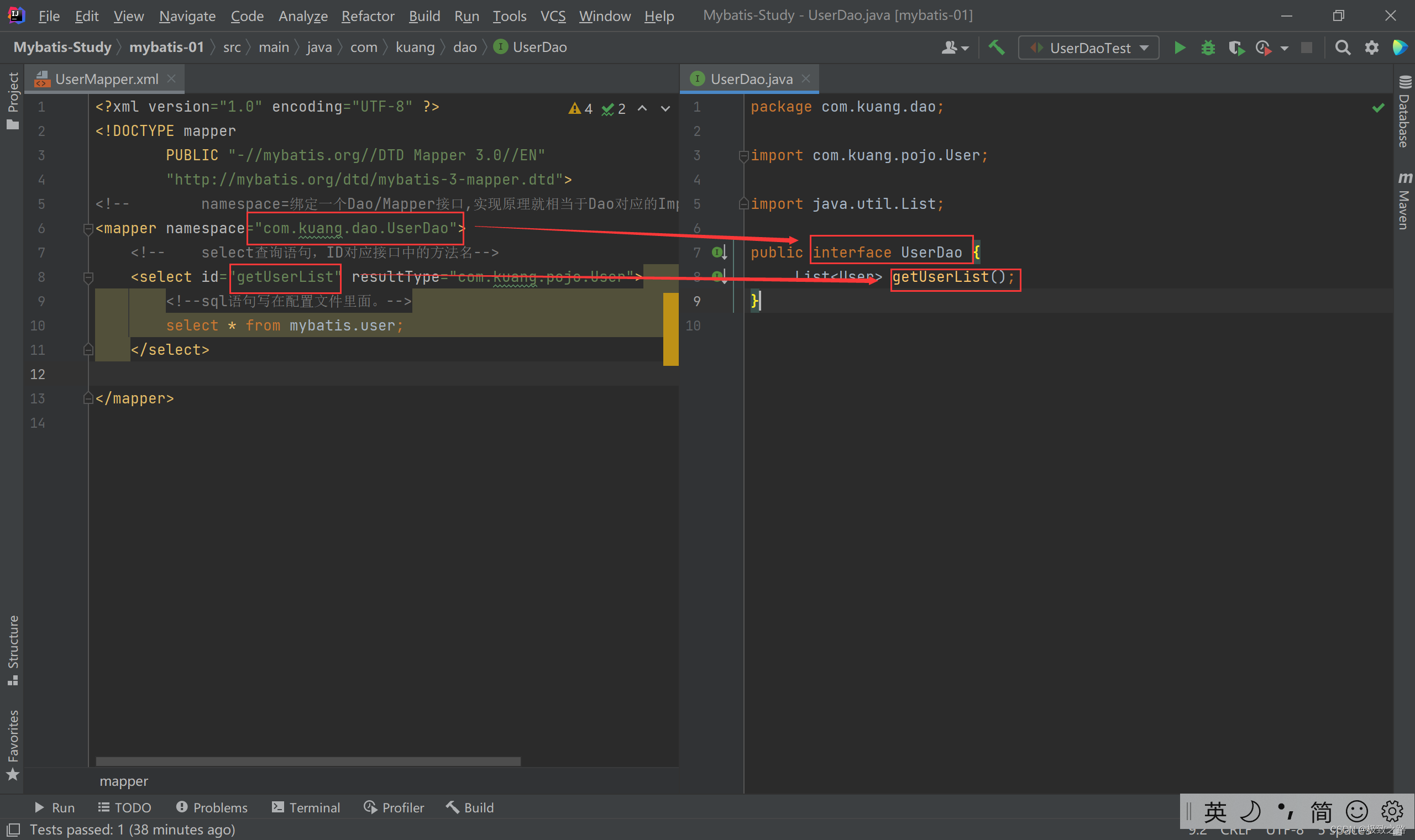
2.mybatis三个核心接口:
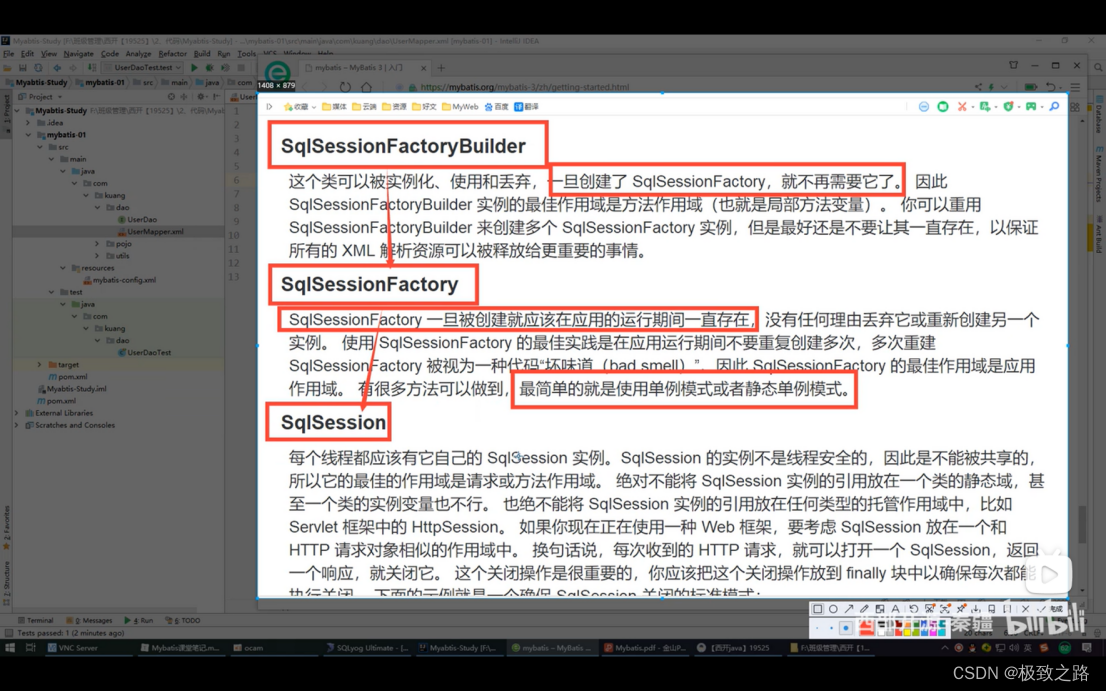

sqlSession的关闭操作非常重要。
三、增删改查实现
(1)namespace
xml文件在这里注册了,注册时绑定的namespace命名空间。通过这个xml文件去找实例的接口。
因此namespace中的包名要和Dao/Mapper接口中的包名一致。
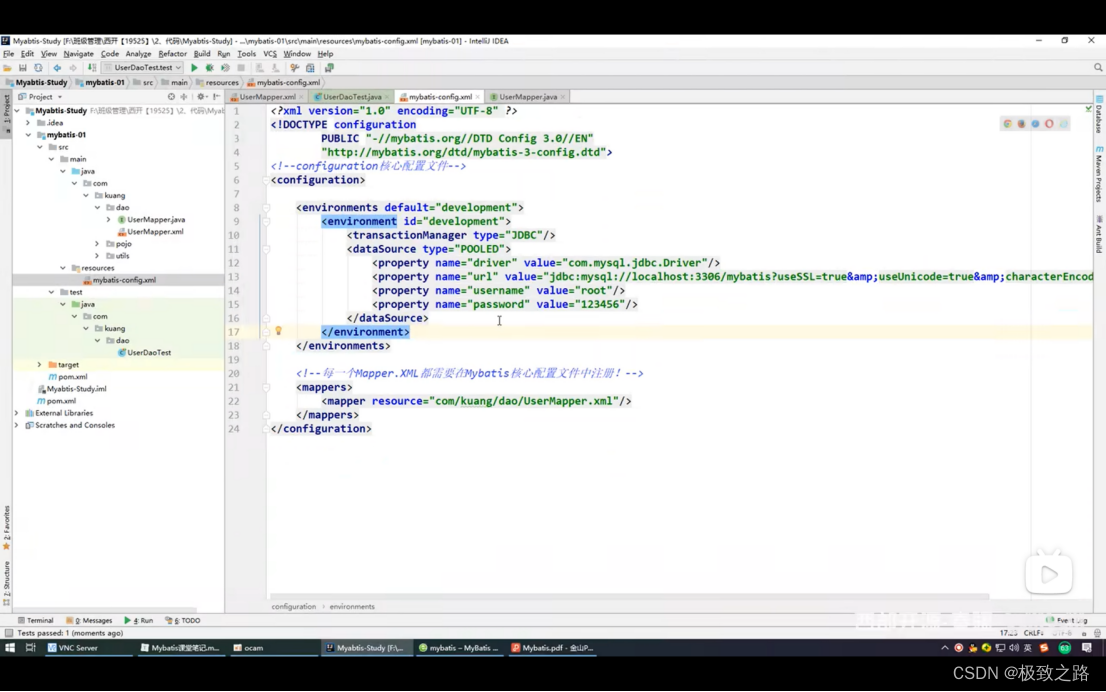
- id:就是对应namespace中的方法名。
- parameterType:参数类型。
- resultType:sql语句执行的返回值。

(2)select
1.编写接口:
// 查询全部用户
List<User> getUserList();
//根据id查询用户
User getUserById(int id);
2.编写对应的mapper中的sql语句:
<!-- select查询语句,ID对应接口中的方法名-->
<select id="getUserList" resultType="com.kuang.pojo.User">
<!--sql语句写在配置文件里面。-->
select * from mybatis.user;
</select>
<!-- 根据id查询用户 -->
<select id="getUserById" parameterType="int" resultType="com.kuang.pojo.User">
select * from mybatis.user where id=#{id}
</select>
3.测试:
@Test
public void getUserById(){
SqlSession sqlSession = MybatisUtils.getSqlSession();
UserMapper mapper = sqlSession.getMapper(UserMapper.class);
User userById = mapper.getUserById(1);
System.out.println(userById);
sqlSession.close();
}
(3)insert
1.编写接口:
// insert 一个用户
int addUser(User user);
2.编写对应的mapper中的sql语句:
<!-- 插入一个用户-->
<insert id="addUser" parameterType="com.kuang.pojo.User">
insert into mybatis.`user` VALUES(#{id},#{name},#{pwd})
</insert>
3.测试:
@Test
public void addUser(){
SqlSession sqlSession = MybatisUtils.getSqlSession();
UserMapper mapper = sqlSession.getMapper(UserMapper.class);
int user = mapper.addUser(new User(5, "擎天柱", "111111"));
System.out.println(user);
sqlSession.commit();
sqlSession.close();
}
(4)update
1.编写接口:
// 修改一个用户
int updateUser(User user);
2.编写对应的mapper中的sql语句:
<!-- 修改用户-->
<update id="updateUser" parameterType="com.kuang.pojo.User">
update mybatis.user set name=#{name},pwd=#{pwd} where id=#{id}
</update>
3.测试:
@Test
public void updateUser(){
SqlSession sqlSession = MybatisUtils.getSqlSession();
UserMapper mapper = sqlSession.getMapper(UserMapper.class);
int update = mapper.updateUser(new User(4, "大黄蜂", "123456"));
System.out.println(update);
sqlSession.commit();
sqlSession.close();
}
(5)delete
1.编写接口:
// 删除一个用户
int delUser(int id);
2.编写对应的mapper中的sql语句:
<!--删除用户-->
<delete id="delUser" parameterType="int">
delete from mybatis.`user` where id =#{id}
</delete>
3.测试:
@Test
public void delUser(){
SqlSession sqlSession = MybatisUtils.getSqlSession();
UserMapper mapper = sqlSession.getMapper(UserMapper.class);
int i = mapper.delUser(4);
System.out.println(i);
sqlSession.commit();
sqlSession.close();
}
(6)注意事项
- 1.所有的操作只跟接口和配置文件有关。实体类和工具类不需要变。
- 2.sqlSession默认开启事务,最后需要提交事务,才会将数据写入导数据库中。(增删改需要提交事务)
sqlSession.commit();
- 3.增删改可以不用返回值
- 4.1.这个地方必须是包名.不是/
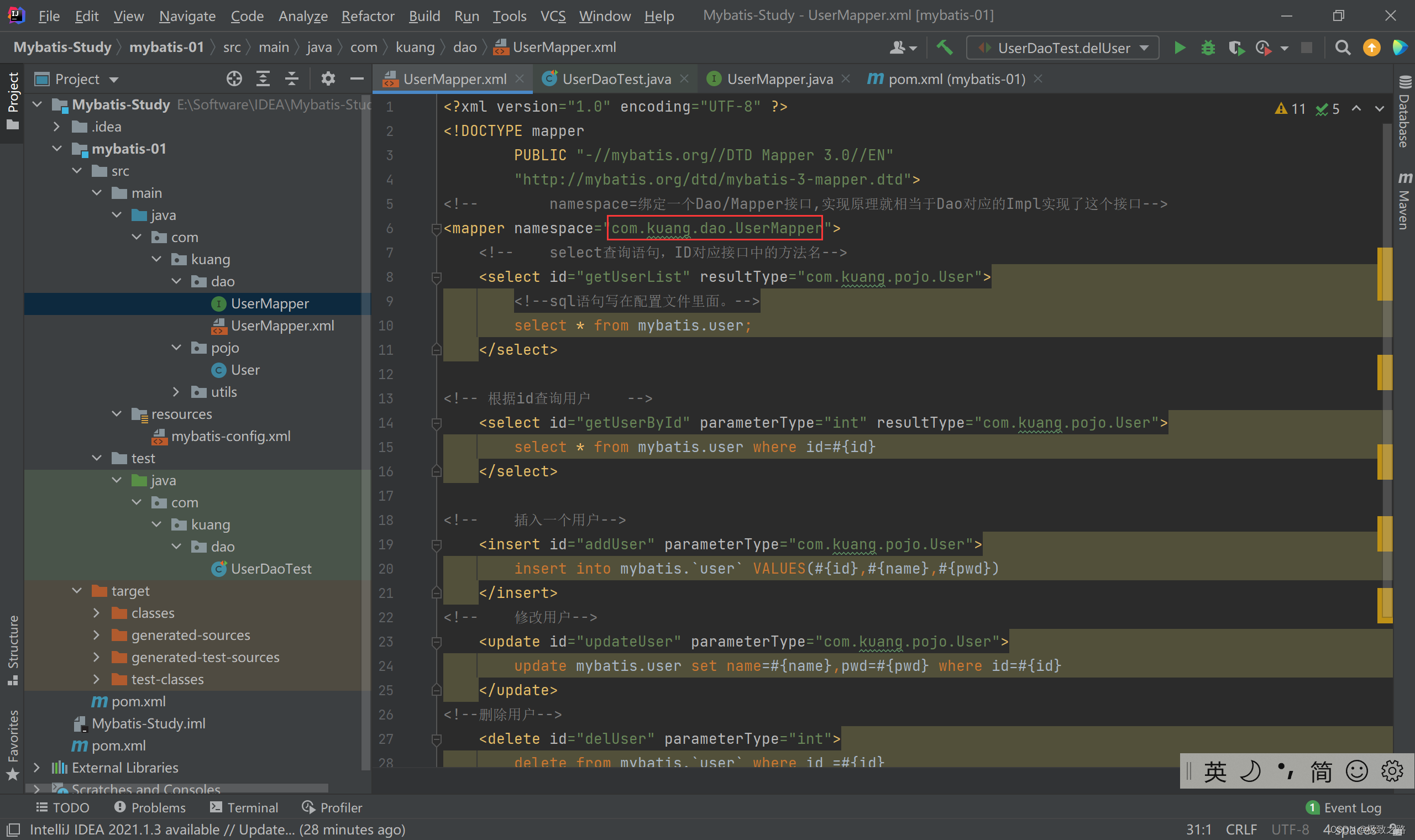
- 4.2.crud对应的标签不要匹配错。
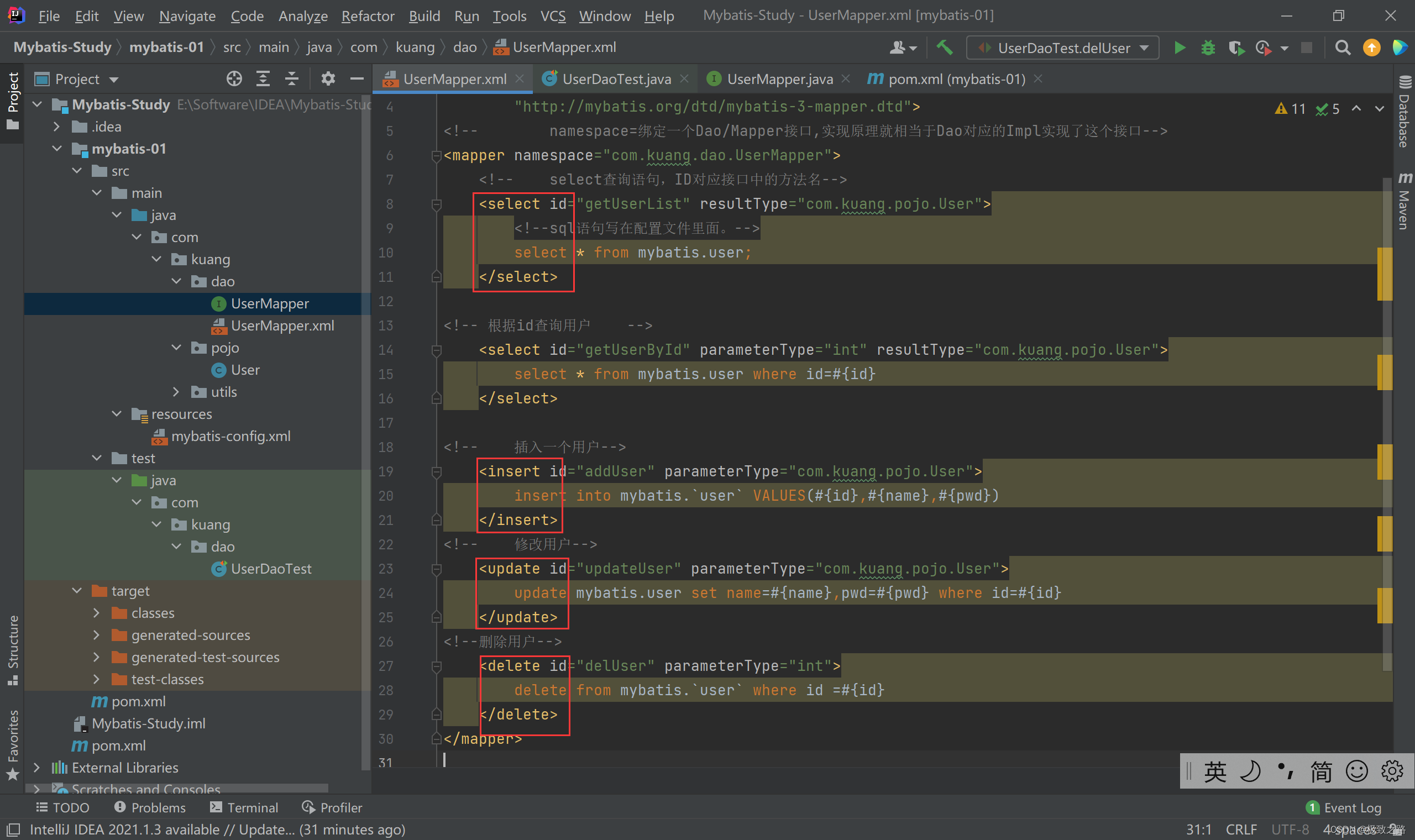
- 4.3.resource资源路径,这里是/代表一个文件路径。

- 4.4.mybatis核心配置文件中的代码不要写错。
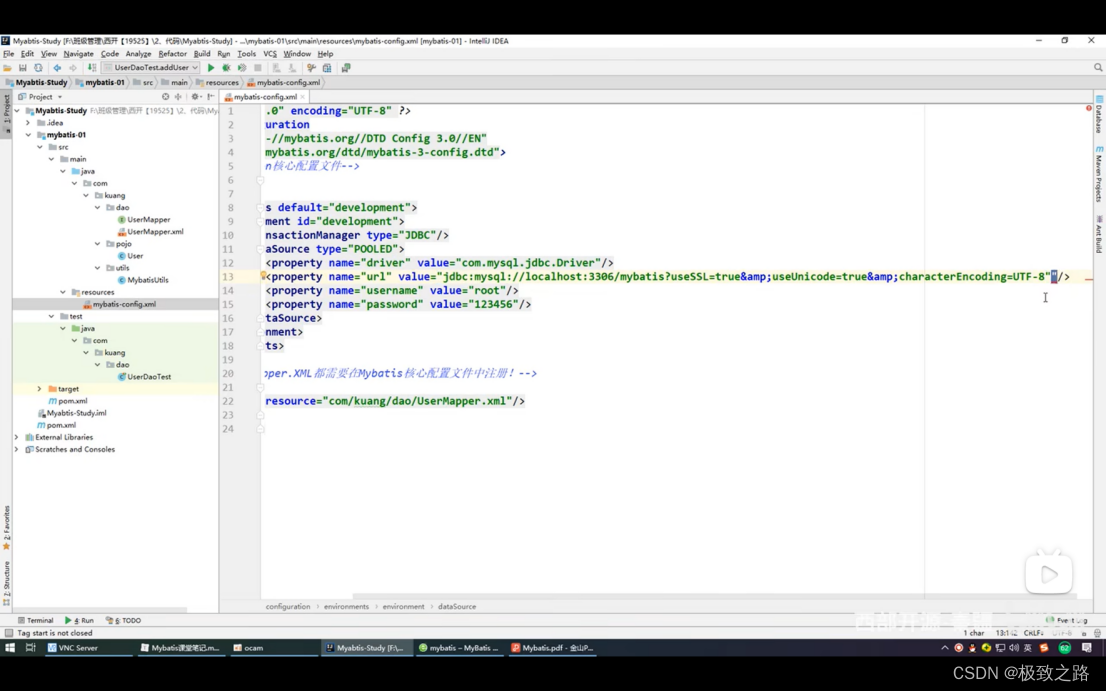
比如这里多了个引号。
- 4.5. 读错从下往上读,读最下面的这个错。
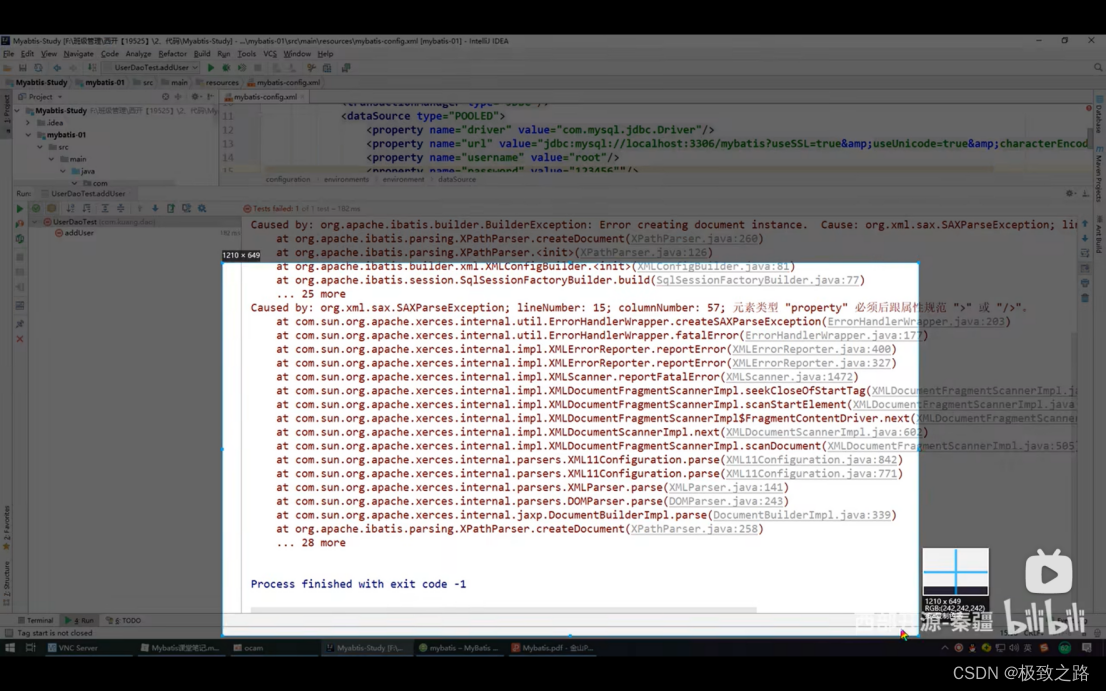
- 4.6.空指针异常:
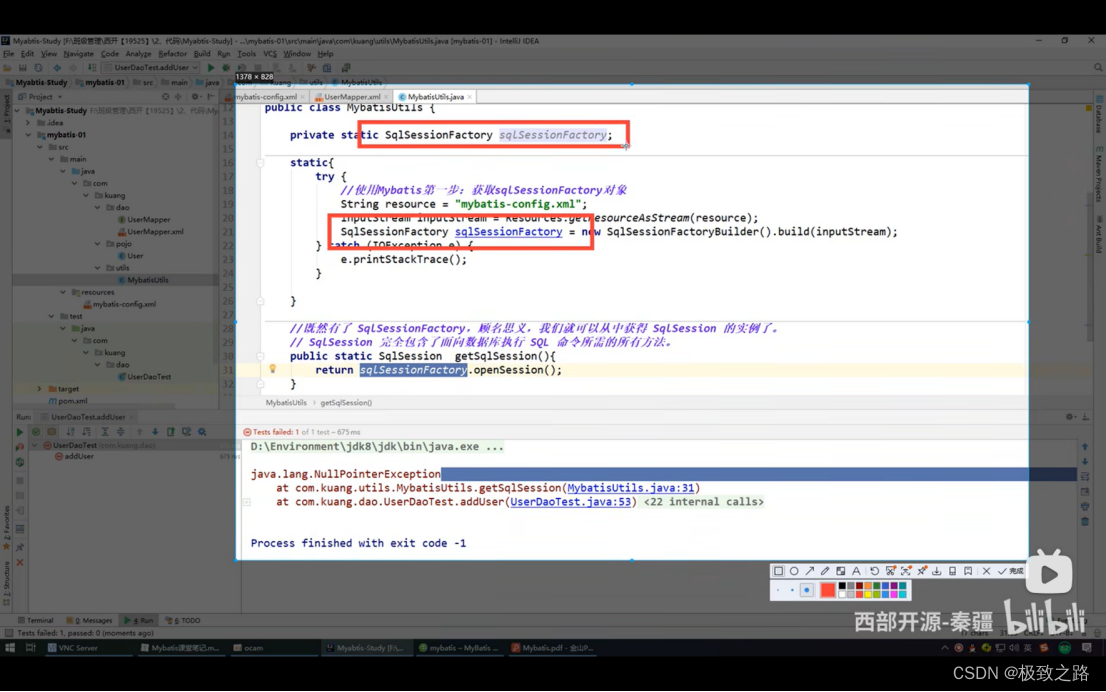
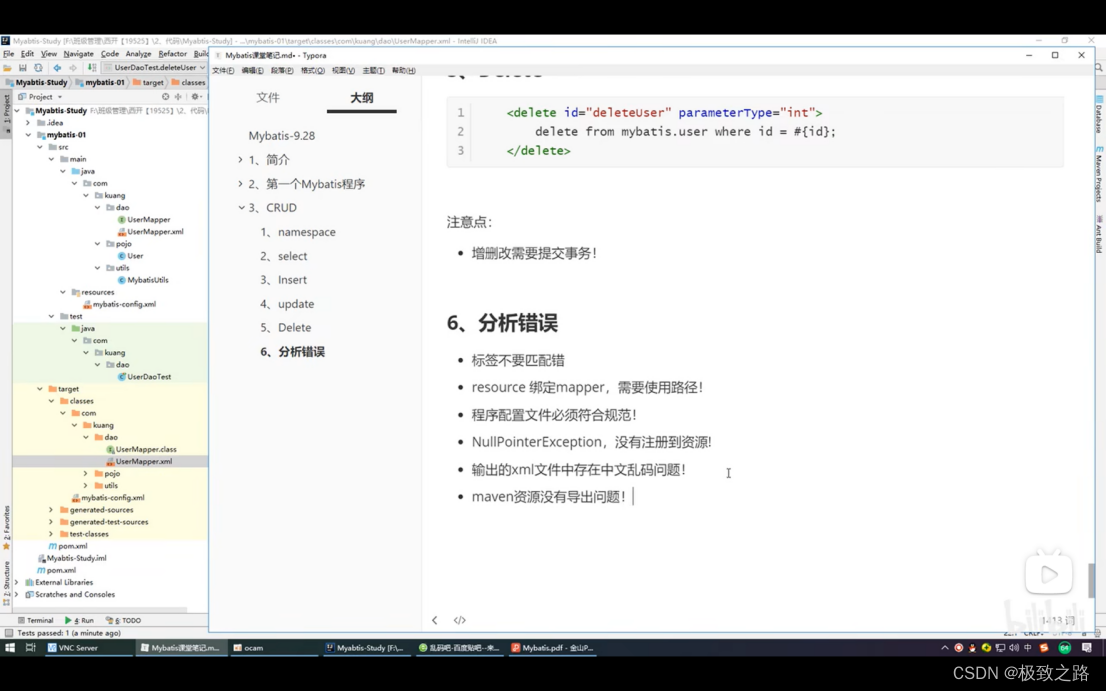
(7)万能的Map
假设我们的实体类,或者数据库中的表,字段或者参数过多,我们应当考虑使用Map!
接口中方法:
// map查询用户
User getUserById2(Map<String,Object> map);
xml配置文件:
<!-- map查询用户-->
<select id="getUserById2" parameterType="map" resultType="user">
select * from `user` where id=#{userId} and `name`=#{Name}
</select>
测试:
@Test
public void getUserById2(){
SqlSession sqlSession = MybatisUtils.getSqlSession();
UserMapper mapper = sqlSession.getMapper(UserMapper.class);
Map<String,Object> map=new HashMap<String, Object>();
map.put("userId",1);
map.put("Name","zhangsan");
User userById = mapper.getUserById2(map);
System.out.println(userById);
sqlSession.close();
}
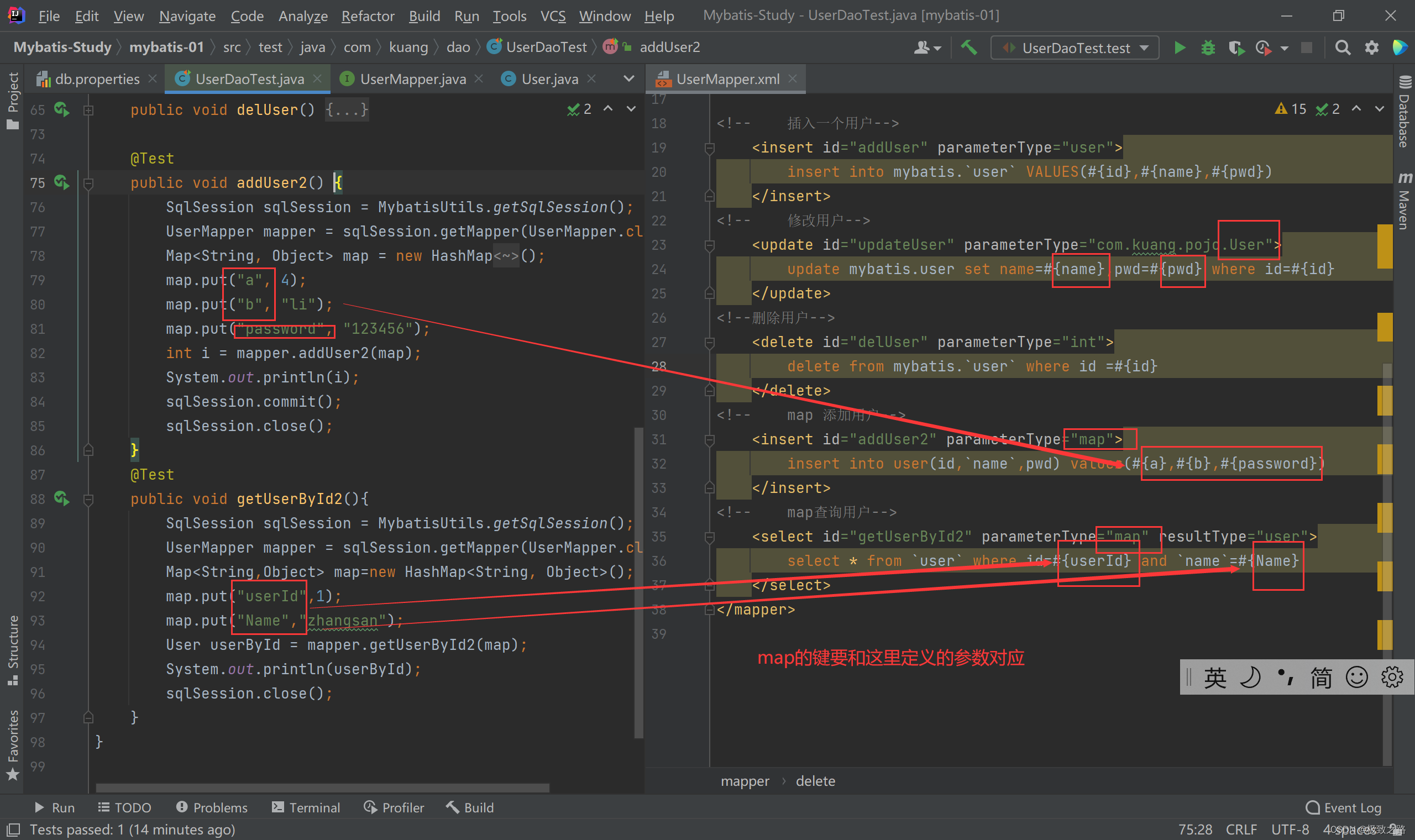
- Map传递参数,是在sql中取出key,sql中的参数可以任意写,但要和key对应。
- 对象传递参数,是在sql中取对象的属性。
- 只有一个基本类型参数的情况下,可以直接在sql中取到!
- 多个参数用Map,或者注解
- map相比起实体类,map可定制化参数。
理解思想。
(8)模糊查询
重点是思想
List<User> getUserLike(String value);
<select id="getUserLike" parameterType="string" resultType="com.kuang.pojo.User">
SELECT * FROM `user` where `name` like #{value}
</select>
<!-- select * from `user` where `name` like "%"#{value}"%"-->
@Test
public void getUserLike(){
SqlSession sqlSession = MybatisUtils.getSqlSession();
UserMapper mapper = sqlSession.getMapper(UserMapper.class);
List<User> userLike = mapper.getUserLike("%李%");
// List<User> userLike = mapper.getUserLike("李");
for (User user : userLike) {
System.out.println(user);
}
sqlSession.close();
}
两种方式:要么在里面写死,通过参数传递符号,要么在sql里面拼接死。
即:
- 1.java代码执行的时候,传递通配符%%
- 2.在sql拼接中使用通配符(存在sql注入问题)
四、配置解析
如果不理解配置解析,mybatis只会增删改查,没什么用。 增删改查jdbc已经够了,配置解析及之后的内容才是需要掌握的。
(1)核心配置文件
- mybatis-config.xml(随意命名,但官方推荐使用这个名字命名)
- 该配置文件中包含了会深深影响myBatis行为的设置和属性信息。
- xml配置需要掌握的东西:
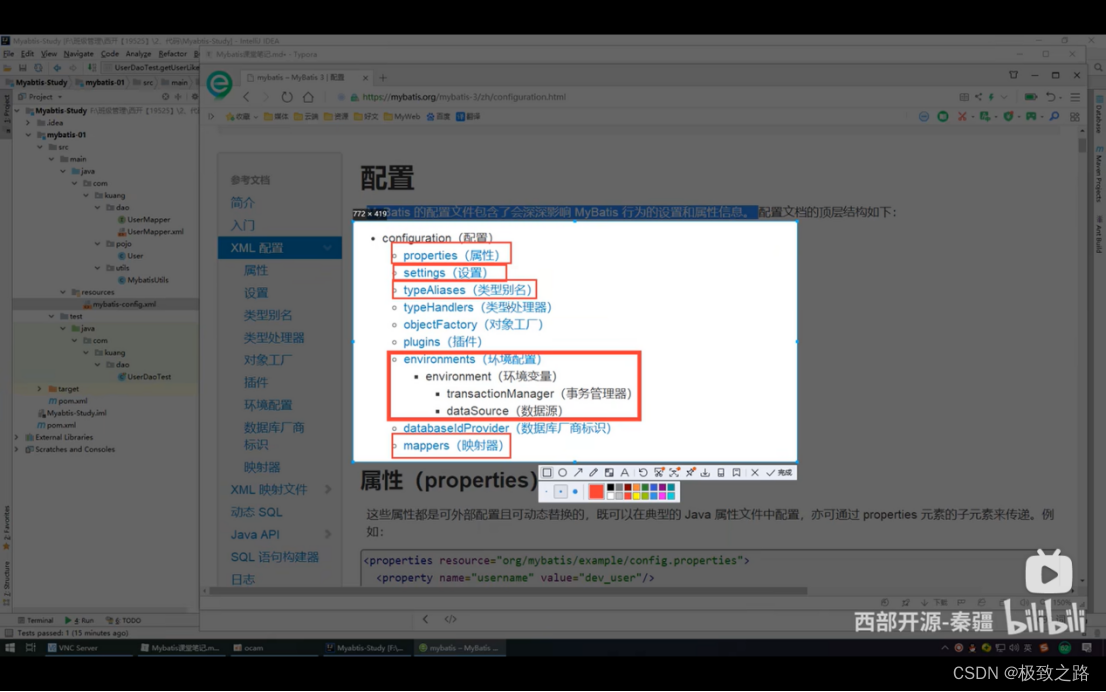
- Properties掌握。
- Settings掌握部分。
- typeAliases完全掌握。
- environments和mappers掌握。
- 其他了解即可。
在该配置文件中,标签放置的位置有一个规定的顺序,不能随意放置标签。

(2)环境配置(environments)
<environments default="development">
<environment id="development">
<transactionManager type="JDBC"/>
<dataSource type="POOLED">
<property name="driver" value="${driver}"/>
<!-- 在xml文件中,&不能用,需要转义&。-->
<property name="url" value="${url}"/>
<property name="username" value="${username}"/>
<property name="password" value="${password}"/>
</dataSource>
</environment>
</environments>
这里知道:
- 1.Mybatis中的事务管理器有两种,一种jdbc,一种managed。
- jdbc可以进行事务的提交和回滚。
- managed几乎并没有做什么。
- 2.默认连接是连接池的实现。
- 3.MyBatis可以配置多套环境。但每次只能选择一套。
(3)属性(Properties)
<!-- <properties resource="db.properties"/>-->
<properties resource="db.properties">
<!-- <property name="username" value="root"/>-->
<!-- <property name="password" value="111111"/>-->
</properties>
db.properties:
driver=com.mysql.jdbc.Driver
url=jdbc:mysql://localhost:3306/mybatis?useSSL=true&useUnicode=true&characterEncoding=UTF-8
username=root
password=123456
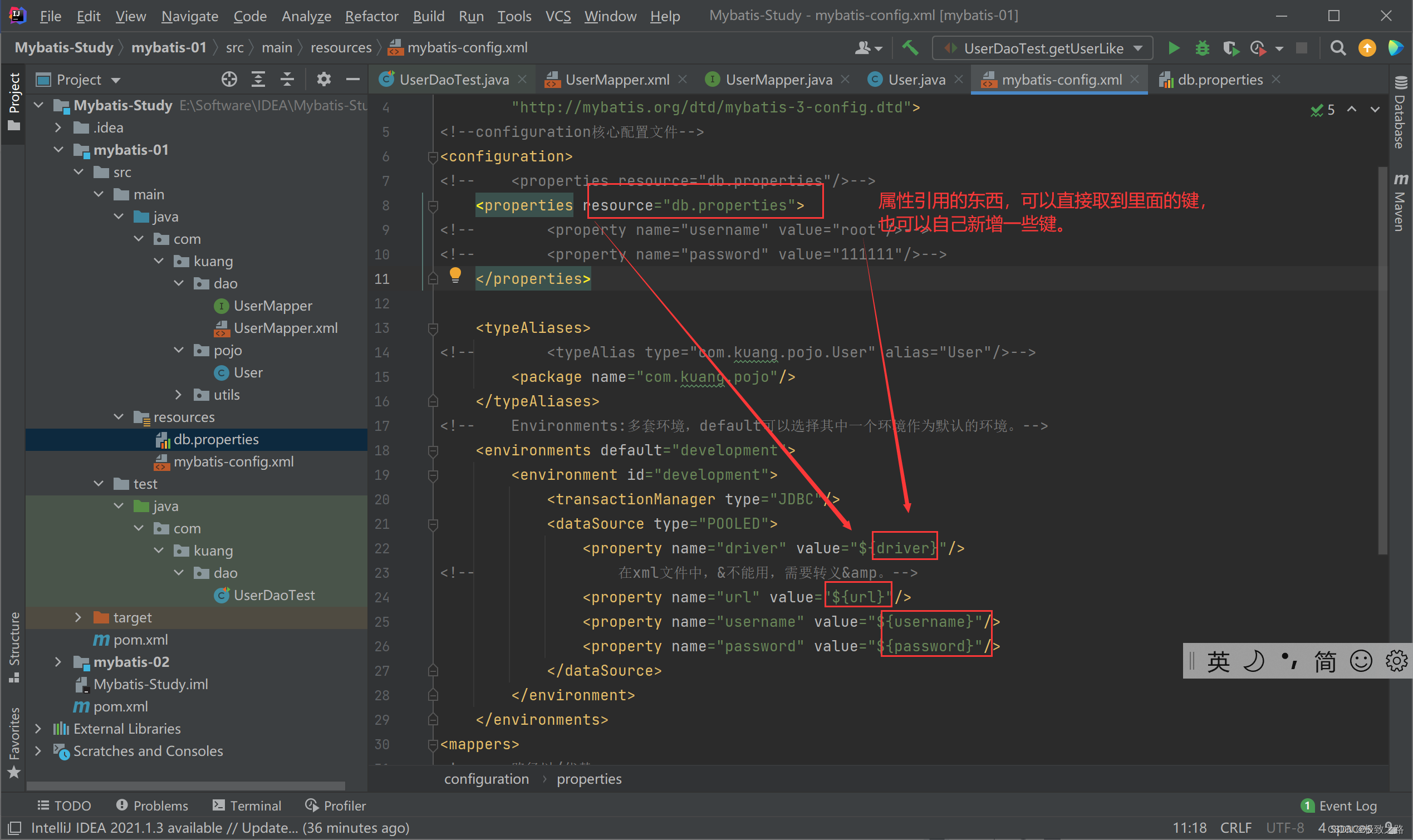
如果配置文件和新加入的属性都有同一个键,就存在优先级的问题。 相同的键,优先使用配置文件的。
(4)类型别名(typeAliases)
- 类型别名可为 Java 类型设置一个别名。 它仅用于 XML 配置,仅在于降低完全限定名的冗余。
- 两种实现方式:
方式一:直接给实体类起别名。
<!-- 可以给实体类器别名-->
<typeAliases>
<typeAlias type="com.kuang.pojo.User" alias="User"/>
</typeAliases>
方法二:可以指定一个包名,MyBatis会在该包下自动搜索需要的Java Bean。
扫描实体类包的方式,它的默认别名就为这个类的类名,首字母小写
<!-- 可以给实体类器别名-->
<typeAliases>
<package name="com.kuang.pojo"/>
</typeAliases>
<select id="getUserList" resultType="user">
select * from mybatis.user
</select>
- 在实体类比较少的时候,使用第一种方式;如果实体类十分多,建议使用第二种。
第二种扫描包方式,在实体类中使用注解可以起别名,实现自定义别名。
@Alias("hello")
public class User{
...
}
-
默认的一些别名:
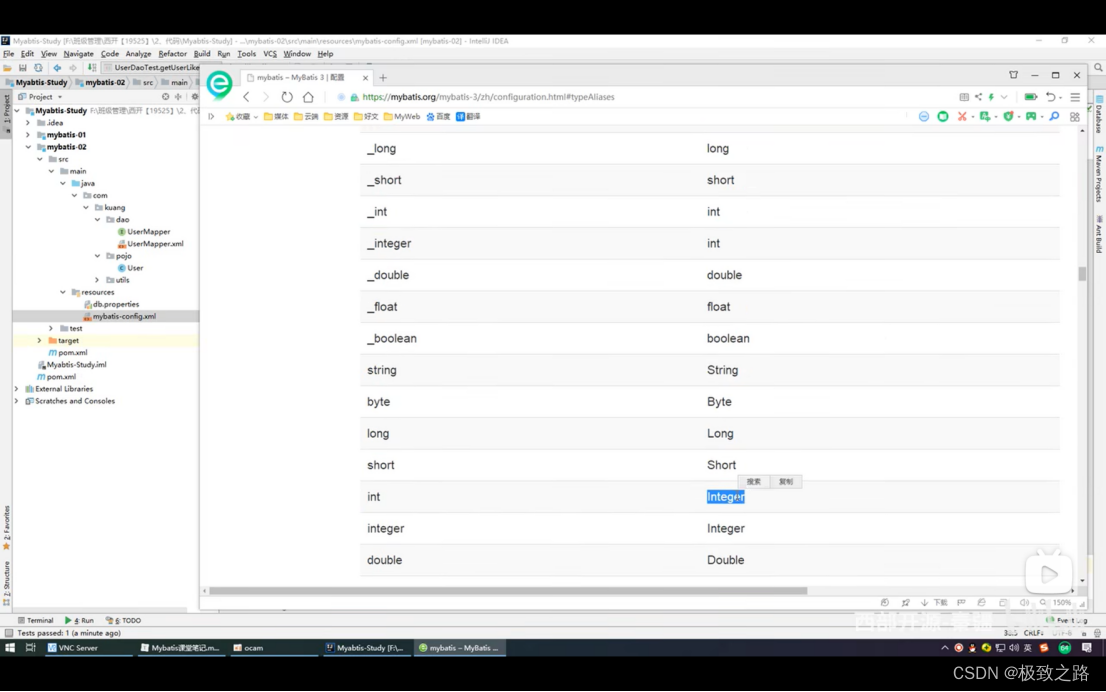

即基本数据类型别名是_基本数据类型,引用是直接首字母小写。
(5)设置(setting)
- 这是 MyBatis 中极为重要的调整设置,它们会改变 MyBatis 的运行时行为。

日志打印:

驼峰命名:

正常数据库和实体类的这样的字段是转换不了的,必须属性和字段对应。
Oracle数据库会把有驼峰的字段全部转换为大写,可读性及其低。因此之后就把字段用_来分割。
- 一个配置完整的 settings 元素的示例如下:
<settings>
<setting name="cacheEnabled" value="true"/>
<setting name="lazyLoadingEnabled" value="true"/>
<setting name="multipleResultSetsEnabled" value="true"/>
<setting name="useColumnLabel" value="true"/>
<setting name="useGeneratedKeys" value="false"/>
<setting name="autoMappingBehavior" value="PARTIAL"/>
<setting name="autoMappingUnknownColumnBehavior" value="WARNING"/>
<setting name="defaultExecutorType" value="SIMPLE"/>
<setting name="defaultStatementTimeout" value="25"/>
<setting name="defaultFetchSize" value="100"/>
<setting name="safeRowBoundsEnabled" value="false"/>
<setting name="mapUnderscoreToCamelCase" value="false"/>
<setting name="localCacheScope" value="SESSION"/>
<setting name="jdbcTypeForNull" value="OTHER"/>
<setting name="lazyLoadTriggerMethods" value="equals,clone,hashCode,toString"/>
</settings>
(6)其他配置(了解)
- typeHandlers(类型处理器)
- objectFactory(对象工厂)
- plugins(插件):
- Mybatis-generator-core
- Mybatis-plus
- 通用mapper
(7)映射器(mappers)
- MapperRegistry:注册绑定我们的Mapper文件,每写一个dao层就要写一个Mapper文件。
- 三种注册方式:
方式一:
<!-- 路径以/代替-->
<mapper resource="com/kuang/dao/UserMapper.xml"/>
方式二:
<!-- 通过扫描类的方式:-->
<mapper class="com.kuang.dao.UserMapper"/>
方式三:
<!-- 通过包扫描的方式:-->
<package name="com.kuang.dao"/>
- 方式一怎么用都可以。(推荐使用方式一)
- 方式二和方式三的使用需要满足以下条件:
- 接口和他的Mapper配置文件必须同名
- 接口和他的Mapper配置文件必须在同一个包下
(8)生命周期和作用域
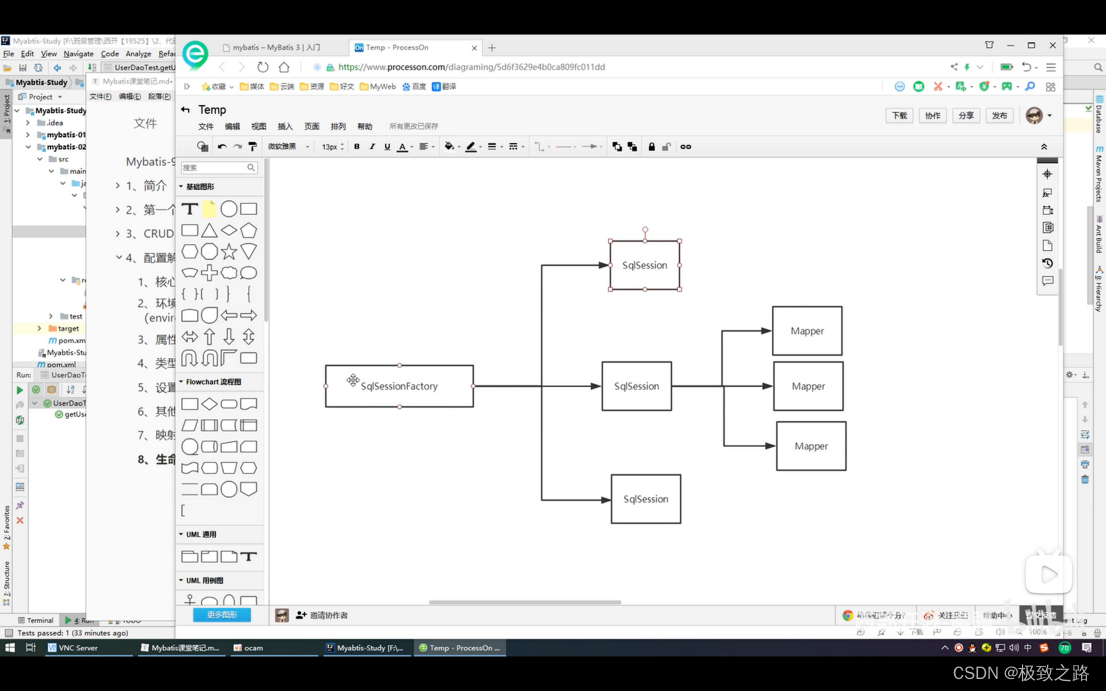
生命周期,和作用域是至关重要的,因为错误的使用会导致非常严重的并发问题。
-
SqlSessionFactoryBuilder:
- 一旦创建了 SqlSessionFactory,就不再需要它了
- 局部变量
-
SqlSessionFactory:
- 类似于数据库连接池
- SqlSessionFactory 一旦被创建就应该在应用的运行期间一直存在,没有 任何理由丢弃它或重新创建另一个实例
- SqlSessionFactory 的最佳作用域是应用作用域。
- 最简单的就是使用单例模式或者静态单例模式
-
SqlSession:
- 连接到连接池的一个请求
- SqlSession 的实例不是线程安全的,因此是不能被共享的,所以它的最佳的作用域是请求或方法作用域
- 用完之后需要赶紧关闭,否则资源被占用!

五、resultMap,解决属性名和字段名不一致的问题。
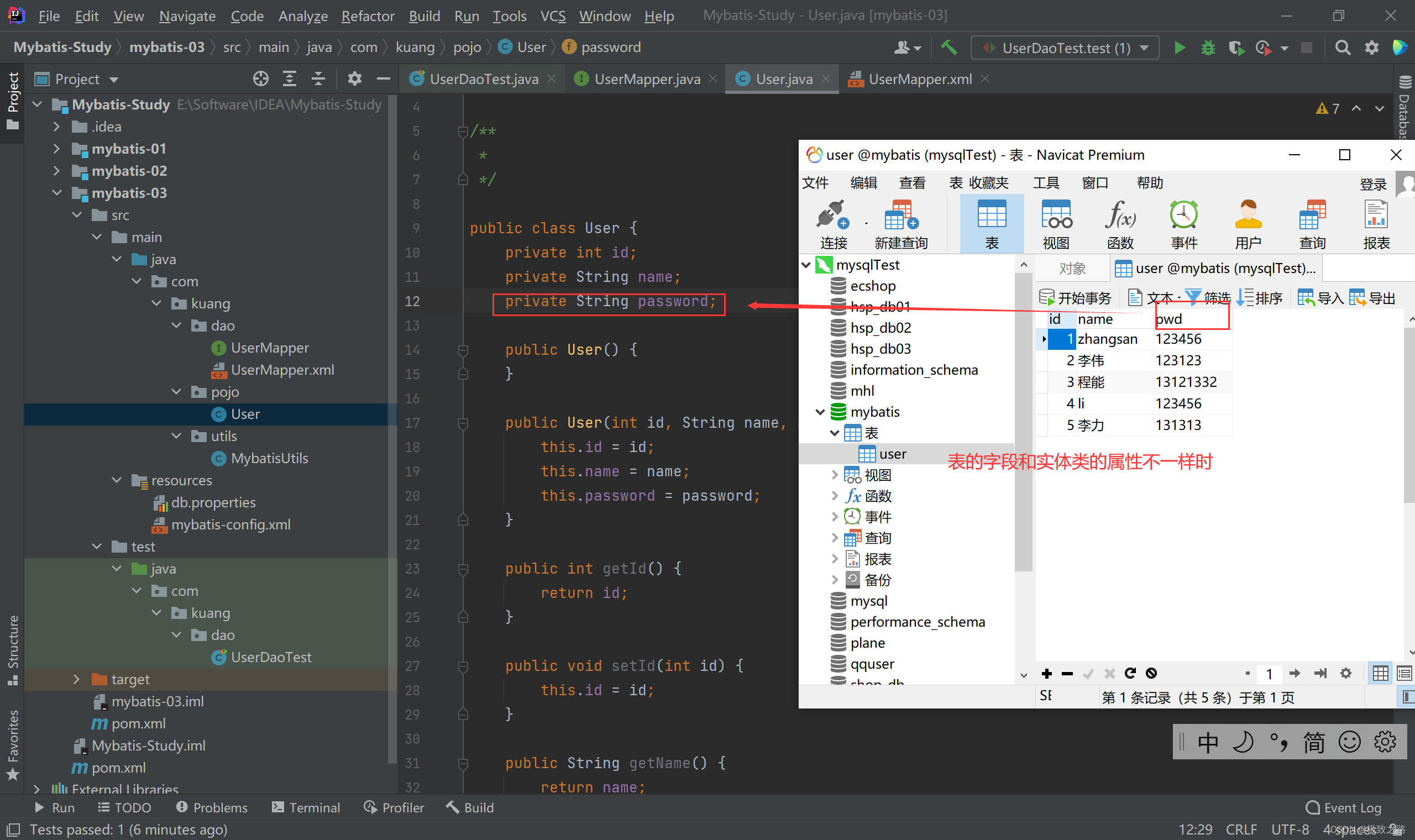

发现取不到数据。
解决方法:
- 1.取别名:
<select id="getUserById" parameterType="int" resultType="user">
select id,name,pwd as password from mybatis.user where id=#{id}
</select>
- 2.resultMap结果集映射:
<!--id是resultMap取得一个名字,type仍然是返回值类型
什么字段和属性不一样就转哪个。
-->
<resultMap id="UserMap" type="user">
<result column="pwd" property="password"/>
</resultMap>
<select id="getUserById" parameterType="int" resultMap="UserMap">
select * from mybatis.user where id=#{id}
</select>
- ResultMap 元素是 MyBatis 中最重要最强大的元素
- ResultMap 的设计思想是,对简单的语句根本不需要配置显式的结果映射,对于复杂一点的语句,只需要描述语句之间的关系就行了
- ResultMap 最优秀的地方在于,虽然你已经对它相当了解了,但是根本不需要显示的调用它们。
六、日志
(1)日志工厂
如果一个数据库操作出现了异常,我们需要排错,日志就是最好的助手
之前排错: sout,debug。现在:日志工厂

1、SLF4J
2、LOG4J(掌握)
3、LOG4J2
4、JDK_LOGGING JDK自带的日志工厂
5、COMMONS_LOGGING
6、STDOUT_LOGGING(掌握,标准日志输出)
7、NO_LOGGING
(2)STDOUT_LOGGING —标准日志输出
在mybatis核心配置文件中,配置日志
<settings>
<setting name="logImpl" value="STDOUT_LOGGING"/>
</settings>

(3)LOG4J
3.1什么是log4j?
Log4j是Apache的一个开源项目,通过使用Log4j,我们可以控制日志信息输送的目的地是控制台、文件、GUI组件
我们也可以控制每一条日志的输出格式
通过定义每一条日志信息的级别,我们能够更加细致地控制日志的生成过程
通过一个配置文件来灵活地进行配置,而不需要修改应用的代码
3.2配置log4j步骤
1.先导入log4j的包
<dependency>
<groupId>log4j</groupId>
<artifactId>log4j</artifactId>
<version>1.2.12</version>
</dependency>
2.log4j.properties
### 将等级为debug的日志输出到console和file两个目的地,console和file的定义 ###
log4j.rootLogger = debug,console,file
### 控制台输出相关配置 ###
log4j.appender.console = org.apache.log4j.ConsoleAppender
log4j.appender.console.Target = System.out
log4j.appender.console.Threshold = debug
log4j.appender.console.layout = org.apache.log4j.PatternLayout
log4j.appender.console.layout.ConversionPattern = %d{ABSOLUTE} %5p %c{1}:%L - %m%n
### 文件输出相关配置 ###
log4j.appender.file = org.apache.log4j.FileAppender
log4j.appender.file.File = ./log/kuang.log
log4j.appender.file.Append = true
log4j.appender.file.Threshold = debug
log4j.appender.file.layout = org.apache.log4j.PatternLayout
log4j.appender.file.layout.ConversionPattern = %-d{yyyy-MM-dd HH:mm:ss} [ %t:%r ] - [ %p ] %m%n
### 日志输出级别,logger后面的内容全部为jar包中所包含的包名 ###
log4j.logger.org.mybatis=debug
log4j.logger.java.sql=debug
log4j.logger.java.sql.Connection=debug
log4j.logger.java.sql.Statement=debug
log4j.logger.java.sql.PreparedStatement=debug
log4j.logger.java.sql.ResultSet=debug
3.配置日志为log4j:
<settings>
<setting name="logImpl" value="LOG4J"/>
</settings>
不能有空格,大小写也不能错。最好复制过来。
4.运行测试:
@Test
public void testlog4j() {
Logger logger = Logger.getLogger(UserDaoTest.class);
logger.info("info:进入了testlog4j");
logger.debug("debug:进入了testlog4j");
logger.error("error:进入了testlog4j");
}
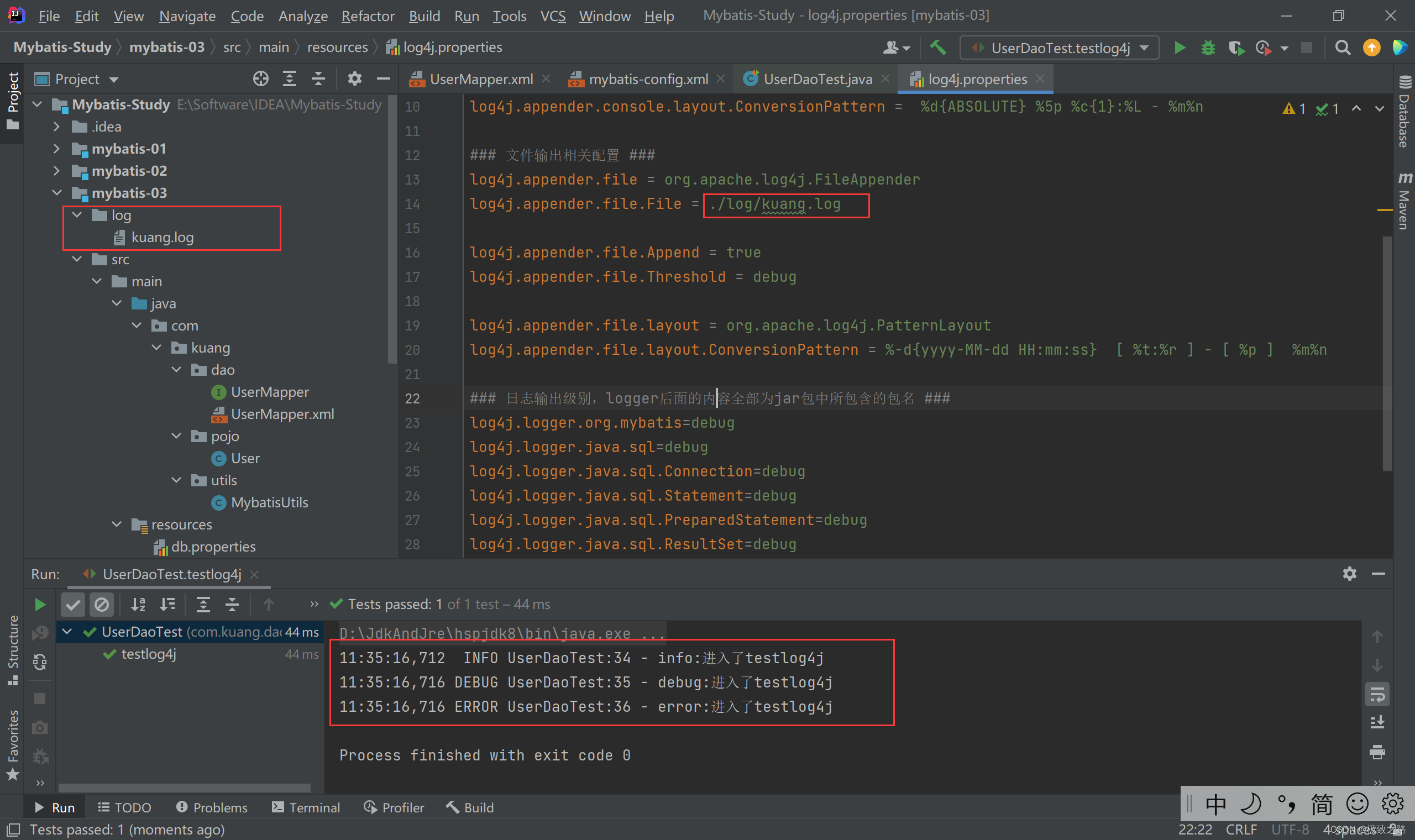
5.简单使用:
- 1.在要使用Log4j的类中,导入包
import org.apache.log4j.Logger;
- 2.日志对象,参数为当前类的class
static Logger logger = Logger.getLogger(UserDaoTest.class);
- 3.输出日志级别
logger.info("info:进入了testlog4j");
logger.debug("debug:进入了testlog4j");
logger.error("error:进入了testlog4j");
七、分页
当数据非常多时,分页可以减少数据的展现量与处理量。
(1)limit实现分页
SELECT * FROM user limit startIndex,pageSize;
SELECT * FROM user limit 0,2;
SELECT * FROM user limit n;#一个参数是[0,n]
//接口
List<User> getUserByLimit(Map<String,Integer> map);
<!--接口对应的xml-->
<select id="getUserByLimit" parameterType="map" resultMap="UserMap">
select * from mybatis.user limit #{startIndex},#{pageSize}
</select>
@Test
public void getUserByLimit(){
SqlSession sqlSession = MybatisUtils.getSqlSession();
UserMapper mapper = sqlSession.getMapper(UserMapper.class);
HashMap<String, Integer> map = new HashMap<>();
map.put("startIndex",1);
map.put("pageSize",2);
List<User> userList = mapper.getUserByLimit(map);
for (User user : userList) {
System.out.println(user);
}
sqlSession.close();
(2)RowBounds实现分页
了解即可,不推荐使用。
//接口
List<User> getUserByRowBounds();
<!-- 分页2-->
<select id="getUserByRowBounds" resultMap="UserMap">
select * from user
</select>
@Test
public void getUserByRowBounds(){
SqlSession sqlSession = MybatisUtils.getSqlSession();
//RowBounds实现
RowBounds rowBounds = new RowBounds(1, 2);
//通过java代码层面实现分页
List<User> userList = sqlSession.selectList("com.kuang.dao.UserMapper.getUserByRowBounds",null,rowBounds);
for (User user : userList) {
System.out.println(user);
}
sqlSession.close();
}
(3)分页插件
八、使用注解开发
(1)面向接口编程
一、概念
1.什么是面向接口编程?
面向接口编程就是先把客户的业务逻辑线提取出来,作为接口,业务具体实现通过该接口的实现类来完成。
当客户需求变化时,只需编写该业务逻辑的新的实现类,通过更改配置文件(例如Spring框架)中该接口
的实现类就可以完成需求,不需要改写现有代码,减少对系统的影响。
复制代码
2.面向接口编程的优点
1 降低程序的耦合性。其能够最大限度的解耦,所谓解耦既是解耦合的意思,它和耦合相对。耦合就是联系
,耦合越强,联系越紧密。在程序中紧密的联系并不是一件好的事情,因为两种事物之间联系越紧密,你更换
其中之一的难度就越大,扩展功能和debug的难度也就越大。
2 易于程序的扩展;
3 有利于程序的维护;
复制代码
3.接口编程在设计模式中的体现:开闭原则
其遵循的思想是: 对扩展开放,对修改关闭。其恰恰就是遵循的是使用接口来实现。在使用面向接口的编程过程
中,将具体逻辑与实现分开,减少了各个类之间的相互依赖,当各个类变化时,不需要对已经编写的系统进行
改动,添加新的实现类就可以了,不在担心新改动的类对系统的其他模块造成影响。
(2)使用注解开发
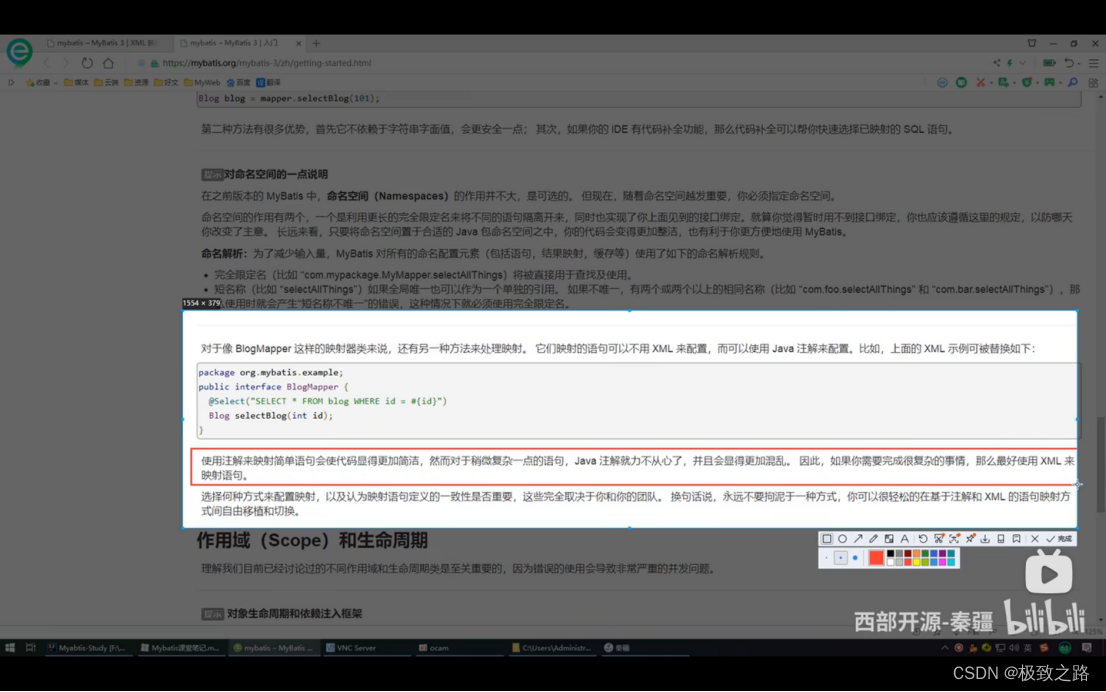
简单的语句可以用注解,复杂的就不能用了。
接口:
public interface UserMapper {
@Select("select * from user")
List<User> getUsers();
}
在Mybatis核心配置文件中绑定接口:
<!--绑定接口-->
<mappers>
<mapper class="com.qjd.dao.UserMapper"/>
</mappers>
测试:
@Test
public void test(){
SqlSession sqlSession = MybatisUtils.getSqlSession();
//底层主要应用反射
UserMapper mapper = sqlSession.getMapper(UserMapper.class);
List<User> users = mapper.getUsers();
for (User user : users) {
System.out.println(user);
}
sqlSession.close();
}
注解和配置文件可以一块用,但类和对应的xml文件必须同名而且在同一个包下
注解底层由反射机制+动态代理实现。

(3)Mybatis详细执行流程

- 建立Mybatis核心配置文件mybatis-config.xml
- 编写工具类MybatisUtils,读取该配置文件,并得到sqlsessionfactory
- 编写接口和对应的XML文件
- 测试
(4)注解实现CRUD
可以在工具类创建的时候实现自动提交事务
sqlSessionFactory.openSession(true);
public interface UserMapper {
@Select("select * from user")
List<User> getUsers();
@Select("select * from user where id=#{uid}")
User getUserById(@Param("uid") int id);
@Insert("insert into user values(#{id},#{name},#{password})")
int addUser(User user);
@Update("update user set name=#{name},pwd=#{password} where id=#{id}")
int updateUser(User user);
@Delete("delete from user where id=#{id}")
int deleteUser(@Param("id") int id);
}
只有一个接口,要在配置中注册接口:
<mappers>
<mapper class="com.kuang.dao.UserMapper"/>
</mappers>
@Test
public void getUserById(){
SqlSession sqlSession = MybatisUtils.getSqlSession();
UserMapper mapper = sqlSession.getMapper(UserMapper.class);
// User userById = mapper.getUserById(1);
// System.out.println(userById);
// insert
// mapper.addUser(new User(6,"令狐冲","123456"));
// mapper.updateUser(new User(4,"任盈盈","123123"));
mapper.deleteUser(3);
sqlSession.commit();
sqlSession.close();
}
(5)其他
- 1.@Param()注解:
- 基本类型的参数或者String需要加上
- 引用类型不需要加
- 如果只有一个基本类型的话,可以忽略,但是建议大家都加上
- 我们在sql中引用的就是我们这里的@Param(“”)中设定的属性名
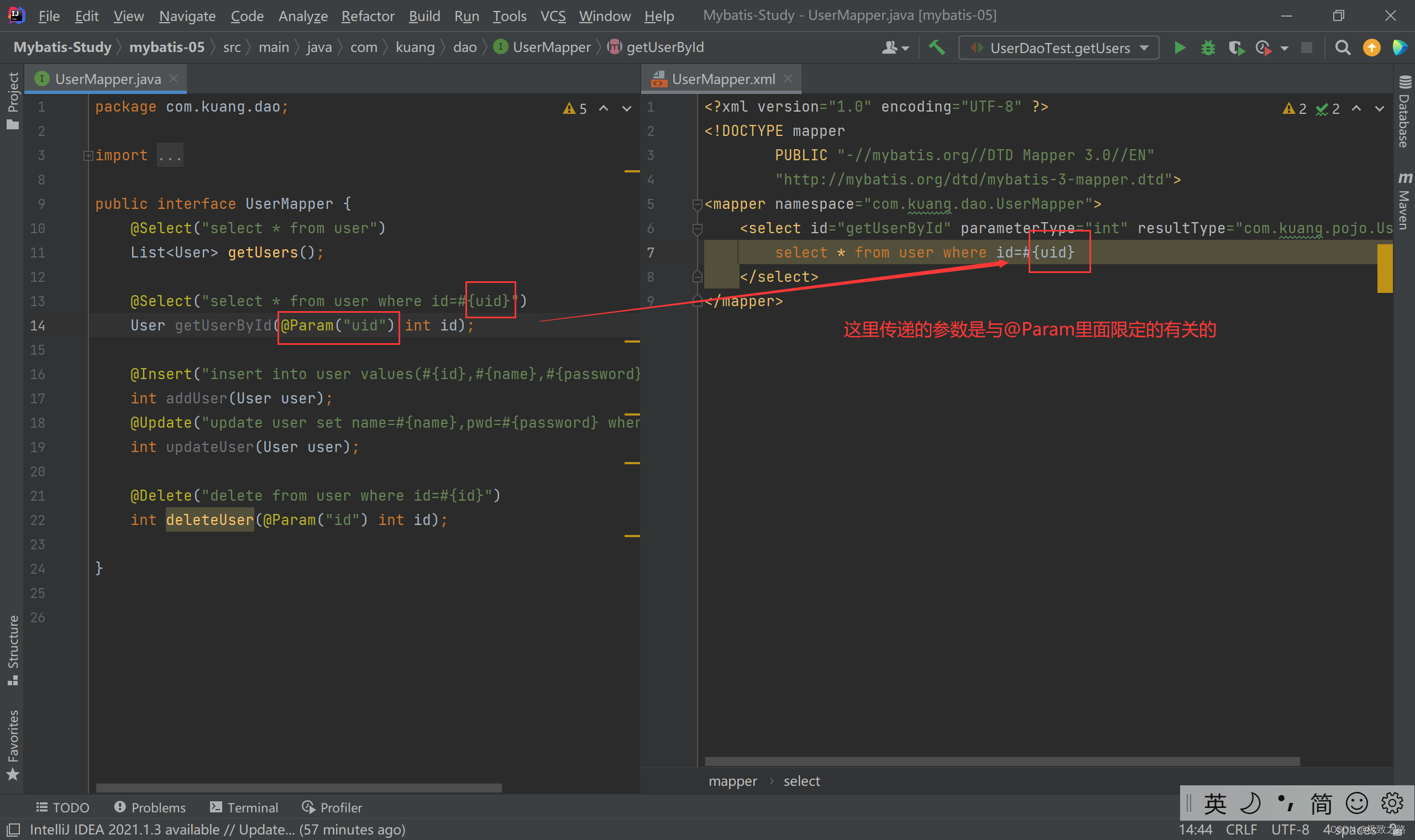
即#{}里面的参数就对应的@Param里面的。就相当于跟你限定了一个名字,之后更改都以这个限定的名字为主。
- 2.#{} 和 ${}
- (1)#{}是预编译处理,$ {}是字符串替换
- (2)mybatis在处理两个字符时,处理的方式也是不同的:
- 处理#{}时,会将sql中的#{}整体替换为占位符(即:?),调用PreparedStatement的set方法来赋值;
- 在处理 $ { } 时,就是把 ${ } 替换成变量的值。
- 3.使用 #{} 可以有效的防止SQL注入,提高系统安全性:
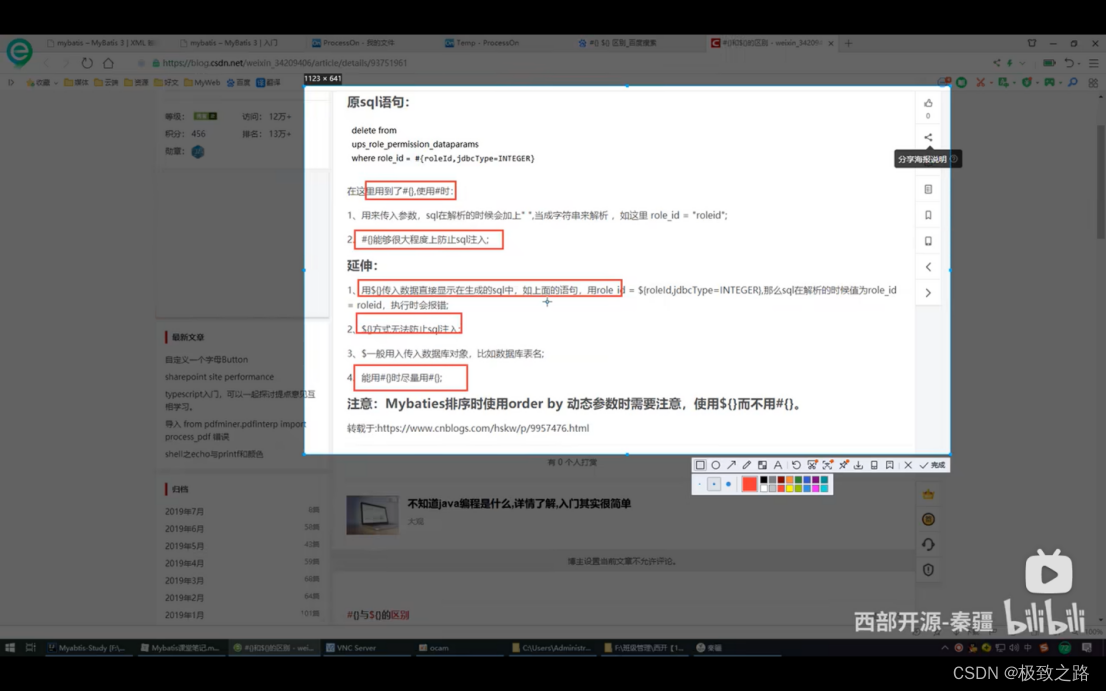
九、Lombok
lombok可以:

使用步骤:
-
在IDEA中安装Lombok插件

如果没有就点中间的浏览器去找。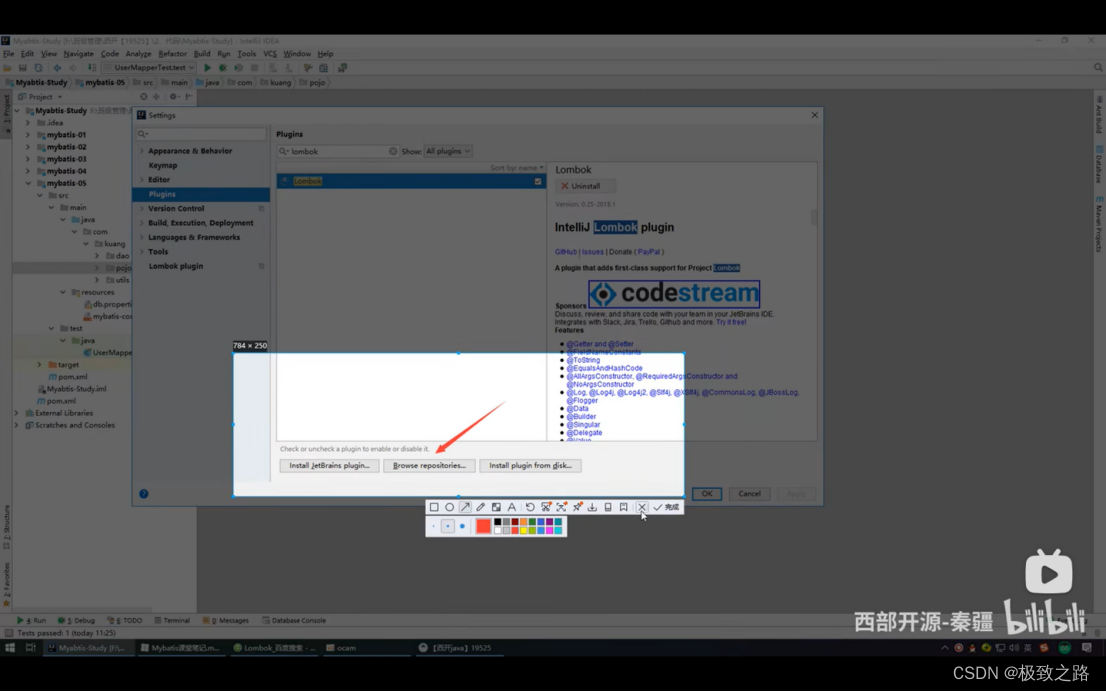
找到一个使用人数特别多的。
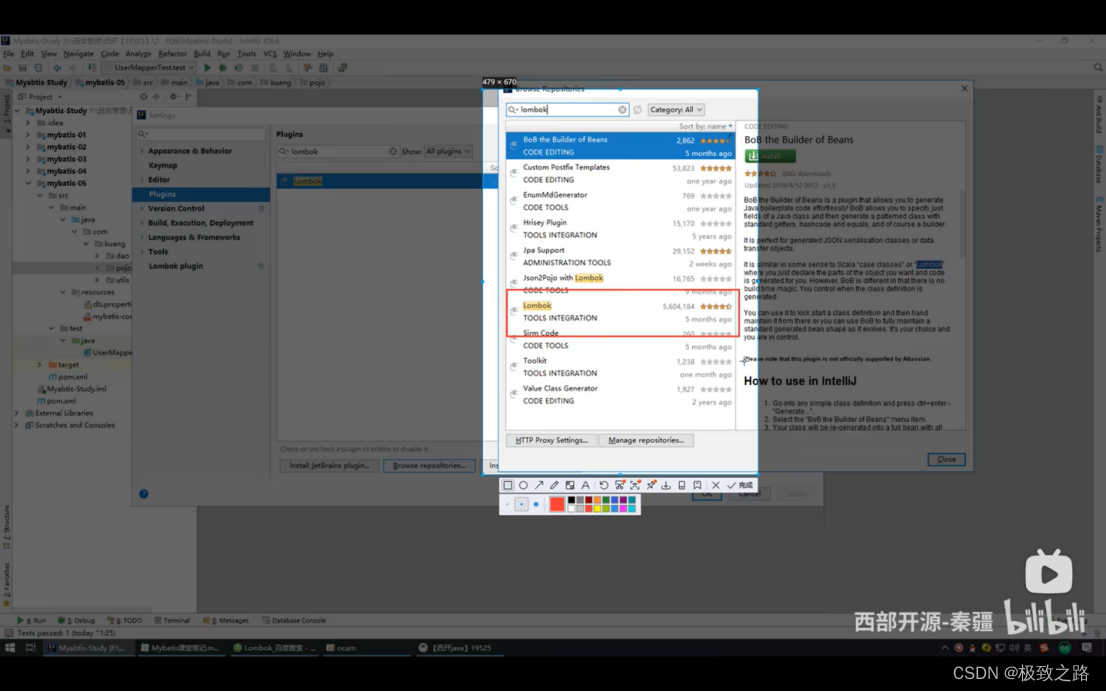
-
在项目中导入Lombok的jar包
<!-- https://mvnrepository.com/artifact/org.projectlombok/lombok -->
<dependency>
<groupId>org.projectlombok</groupId>
<artifactId>lombok</artifactId>
<version>1.18.10</version>
</dependency>
- 在实体类上加注解即可
@Data
@AllArgsConstructor
@NoArgsConstructor
public class User {
private int id;
private String name;
private String password;
}
所有lombok能加的注解都在这里:
@Getter and @Setter
@FieldNameConstants
@ToString
@EqualsAndHashCode
@AllArgsConstructor, @RequiredArgsConstructor and @NoArgsConstructor
@Log, @Log4j, @Log4j2, @Slf4j, @XSlf4j, @CommonsLog, @JBossLog, @Flogger, @CustomLog
@Data
@Builder
@SuperBuilder
@Singular
@Delegate
@Value
@Accessors
@Wither
@With
@SneakyThrows
@val
@var
experimental @var
@UtilityClass
不支持构造器的重载,但构造器可以手动去加。
但lombok能不用就不用。
十、多对一的处理和一对多的处理
(1)测试环境搭建
1.新建实体类Teacher,Student
CREATE TABLE `teacher` (
`id` INT(10) NOT NULL,
`name` VARCHAR(30) DEFAULT NULL,
PRIMARY KEY (`id`)
) ENGINE=INNODB DEFAULT CHARSET=utf8
INSERT INTO teacher(`id`, `name`) VALUES (1, '秦老师');
CREATE TABLE `student` (
`id` INT(10) NOT NULL,
`name` VARCHAR(30) DEFAULT NULL,
`tid` INT(10) DEFAULT NULL,
PRIMARY KEY (`id`),
KEY `fktid` (`tid`),
CONSTRAINT `fktid` FOREIGN KEY (`tid`) REFERENCES `teacher` (`id`)
) ENGINE=INNODB DEFAULT CHARSET=utf8
INSERT INTO `student` (`id`, `name`, `tid`) VALUES ('1', '小明', '1');
INSERT INTO `student` (`id`, `name`, `tid`) VALUES ('2', '小红', '1');
INSERT INTO `student` (`id`, `name`, `tid`) VALUES ('3', '小张', '1');
INSERT INTO `student` (`id`, `name`, `tid`) VALUES ('4', '小李', '1');
INSERT INTO `student` (`id`, `name`, `tid`) VALUES ('5', '小王', '1');
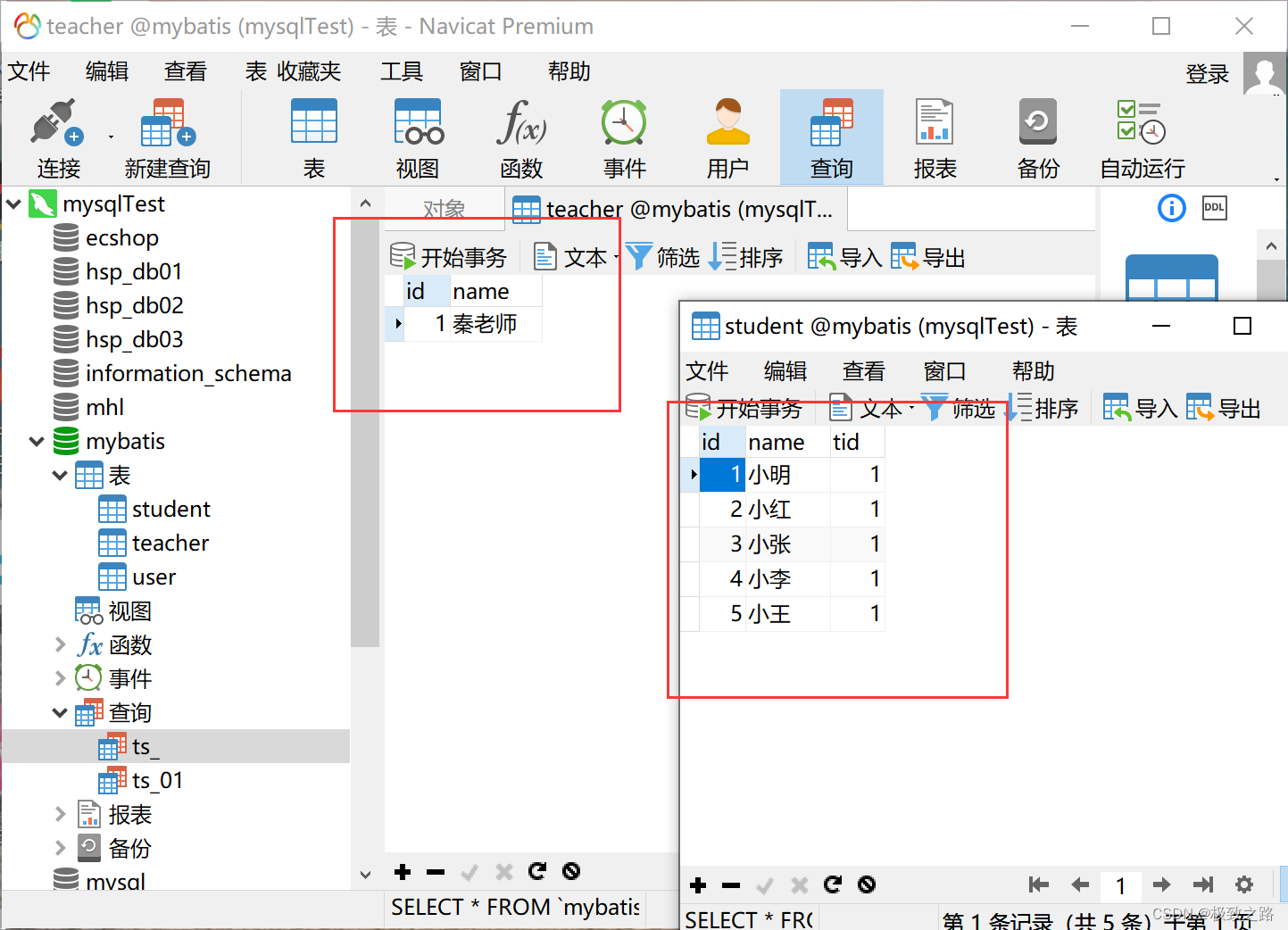
- 建立Mapper接口
public interface TeacherMapper {
@Select("select *from teacher where id=#{tid}")
Teacher getTeacher(@Param("tid") int id);
}
3.建立Mapper.xml文件
<?xml version="1.0" encoding="UTF-8" ?>
<!DOCTYPE mapper
PUBLIC "-//mybatis.org//DTD Config 3.0//EN"
"http://mybatis.org/dtd/mybatis-3-mapper.dtd">
<mapper namespace="com.kuang.dao.TeacherMapper">
</mapper>
4.在核心配置文件中绑定注册我们的Mapper接口或者文件
<!--绑定接口-->
<mappers>
<mapper class="com.qjd.dao.StudentMapper"/>
<mapper class="com.qjd.dao.TeacherMapper"/>
</mappers>
- 测试查询是否能够成功
public class MyTest {
public static void main(String[] args) {
SqlSession sqlSession = MybatisUtils.getSqlSession();
TeacherMapper mapper = sqlSession.getMapper(TeacherMapper.class);
Teacher teacher = mapper.getTeacher(1);
System.out.println(teacher);
sqlSession.close();
}
}
- 结果映射(resultMap)
- association映射对象。
- collection映射集合。
(2)多对一的处理
public interface StudentMapper {
//查询所有的学生信息以及对应的老师信息
//方式一、按照查询嵌套处理
public List<Student> getStudent();
// 方式二、按照结果嵌套查询
public List<Student> getStudent2();
}
public class Student {
private int id;
private String name;
// 每个学生对应1个老师
private Teacher teacher;
}
public class Teacher {
private int id;
private String name;
}
学生和老师
- 对于学生而言,关联··· 多个学生关联一个老师【多对一】
- 对于老师而言,集合··· 一个老师有很多学生 【一对多】
1.按照查询嵌套处理(类似于子查询)
<select id="getStudent" resultMap="StudentTeacher">
select * from student
</select>
<resultMap id="StudentTeacher" type="Student">
<result property="id" column="id"/>
<result property="name" column="name"/>
<collection property="teacher" javaType="Teacher" column="tid" select="getTeacherByStudentTid"/>
</resultMap>
<select id="getTeacherByStudentTid" resultType="Teacher">
select * from teacher where id=#{tid}
</select>

- association映射对象。这里也可以用association

2.按照结果映射
现在像直接用这条语句查,不分开
select s.id sid,s.name sname,t.name tname,t.id tid from student s,teacher t where s.tid=t.id
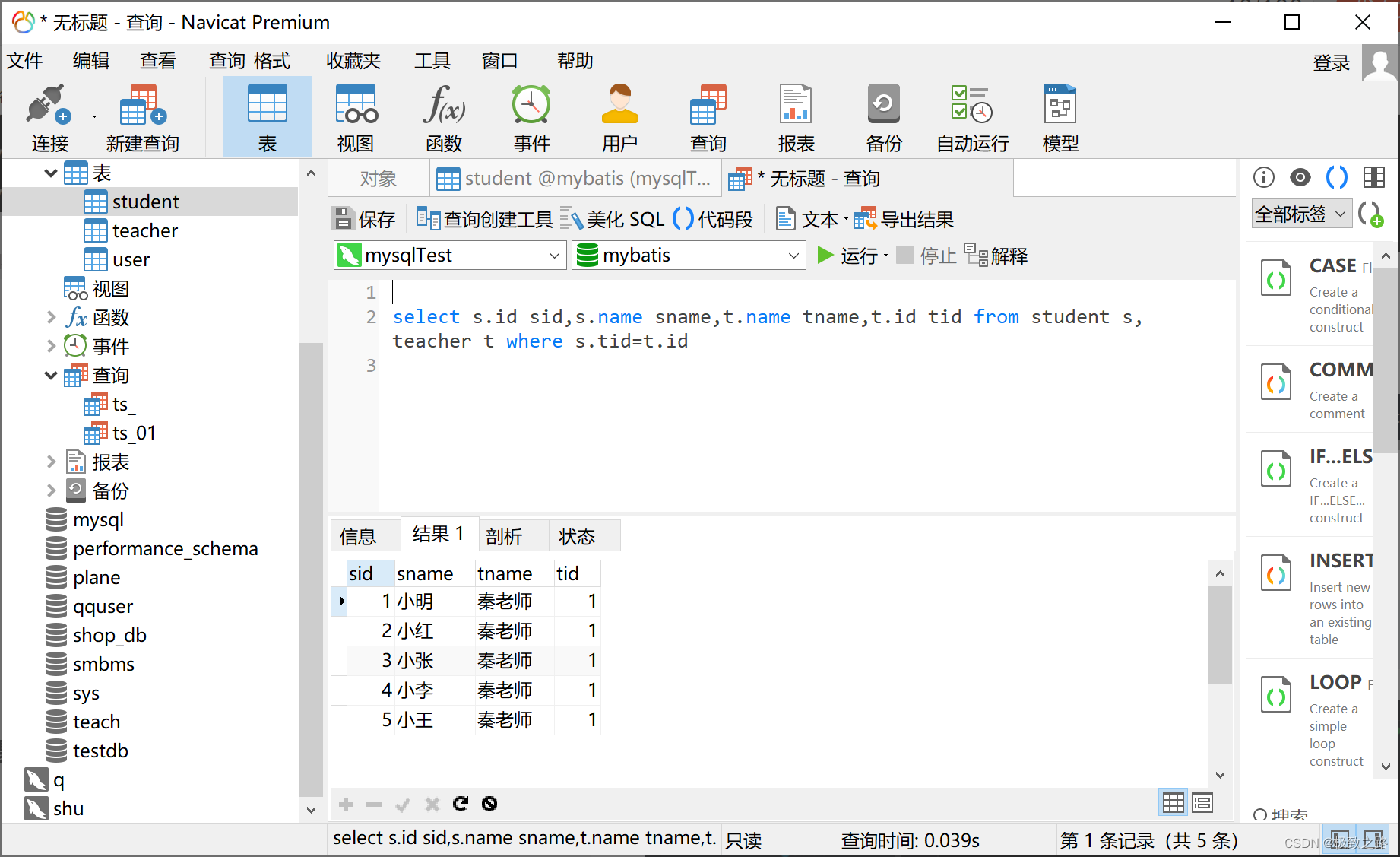
<select id="getStudent2" resultMap="StudentTeacher2">
select s.id sid,s.name sname,t.name tname,t.id tid from student s,teacher t where s.tid=t.id
</select>
<resultMap id="StudentTeacher2" type="Student">
<result property="id" column="sid"/>
<result property="name" column="sname"/>
<association property="teacher" javaType="Teacher">
<result property="id" column="tid"/>
<result property="name" column="tname"/>
</association>
</resultMap>
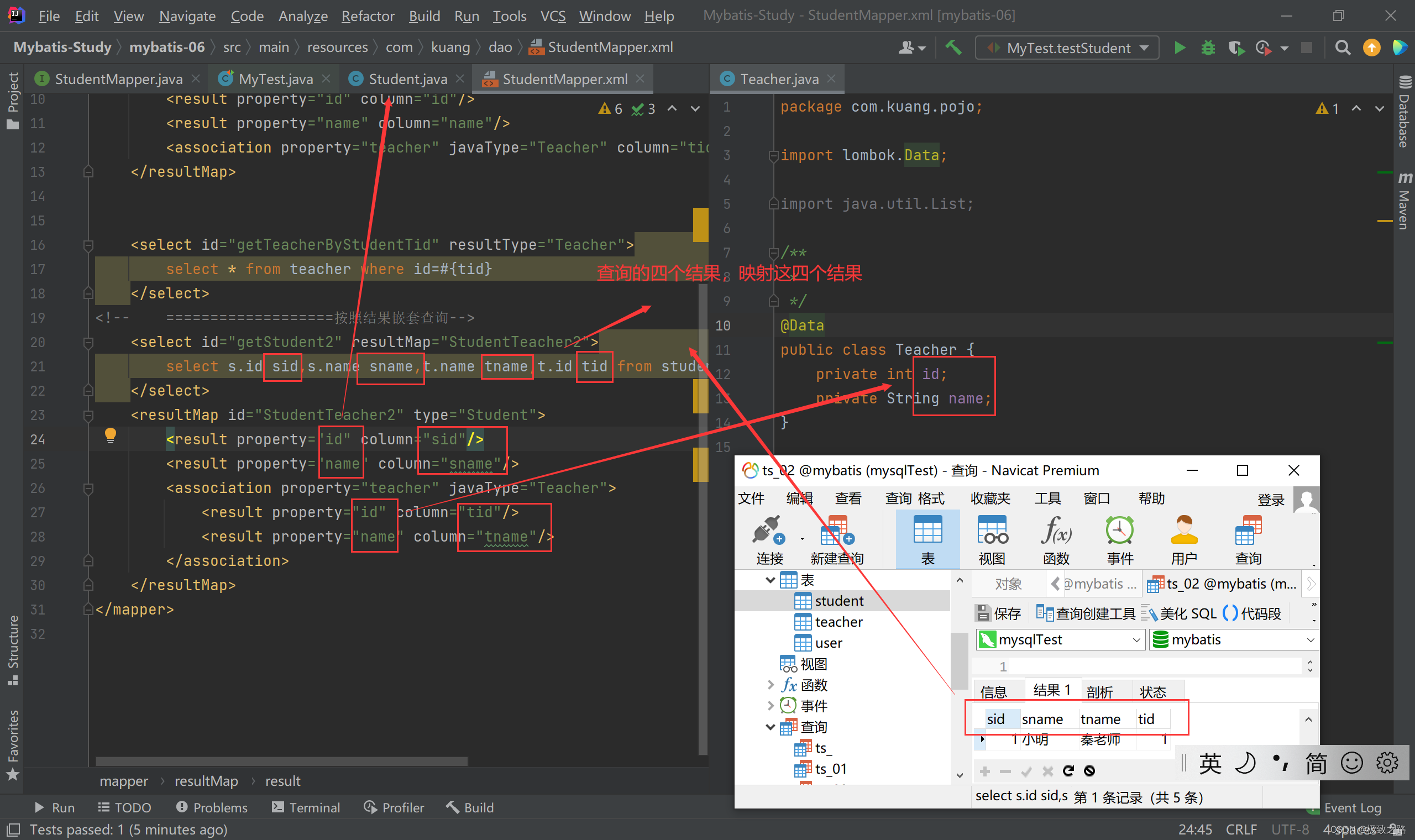
建议使用按照结果进行映射的方式,第一种比较绕。但每个人的情况不一样。
(3)一对多的处理
一个老师对应多名学生:
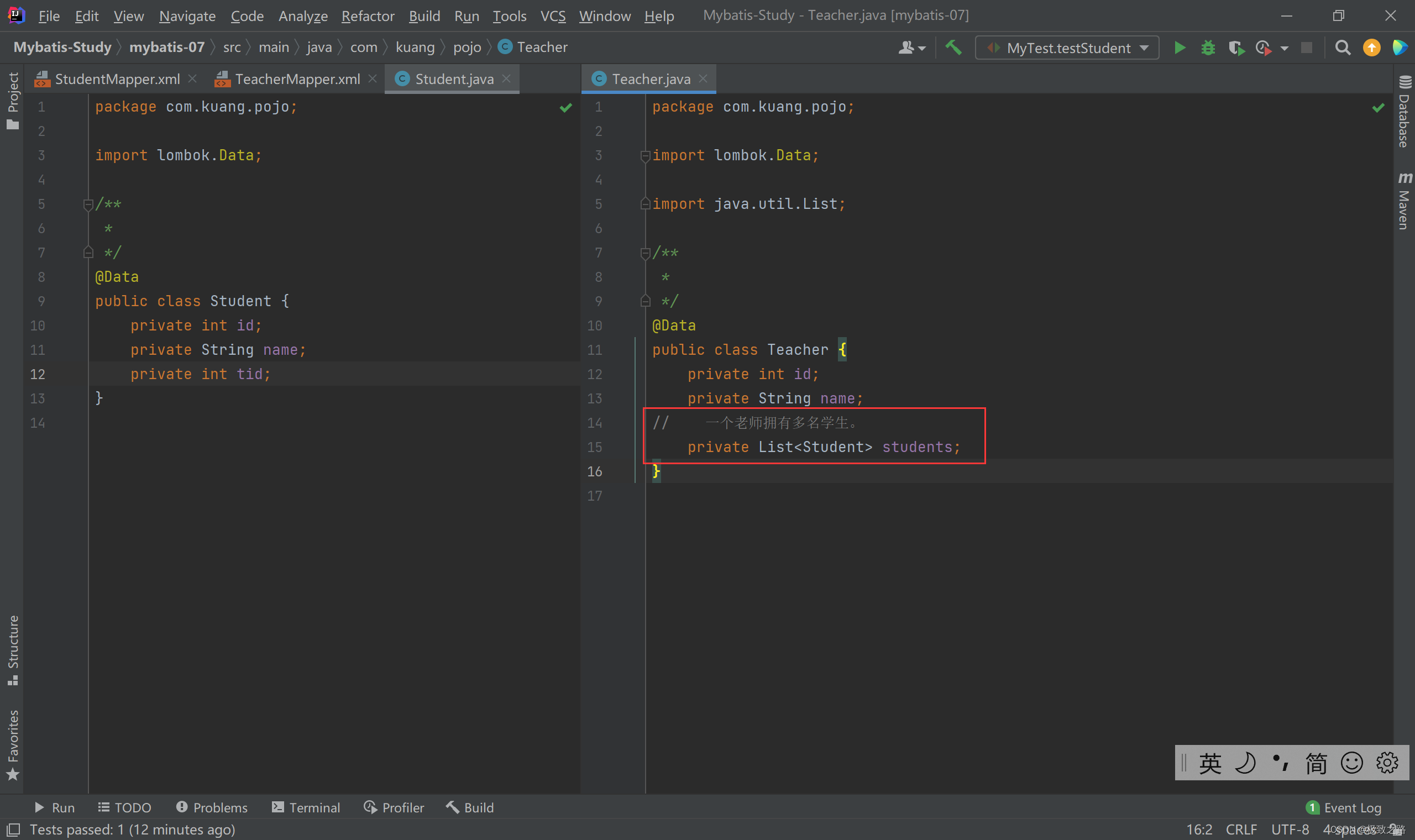
1.方式一、按照结果映射
<select id="getTeacherById" resultMap="TeacherStudent">
select s.id sid,s.`name` sname,t.`name` tname,t.id tid from teacher t,student s where t.id=s.tid and t.id=#{tid}
</select>
<resultMap id="TeacherStudent" type="Teacher">
<result property="id" column="tid"/>
<result property="name" column="tname"/>
<collection property="students" ofType="Student">
<result property="id" column="sid"/>
<result property="name" column="sname"/>
</collection>
</resultMap>
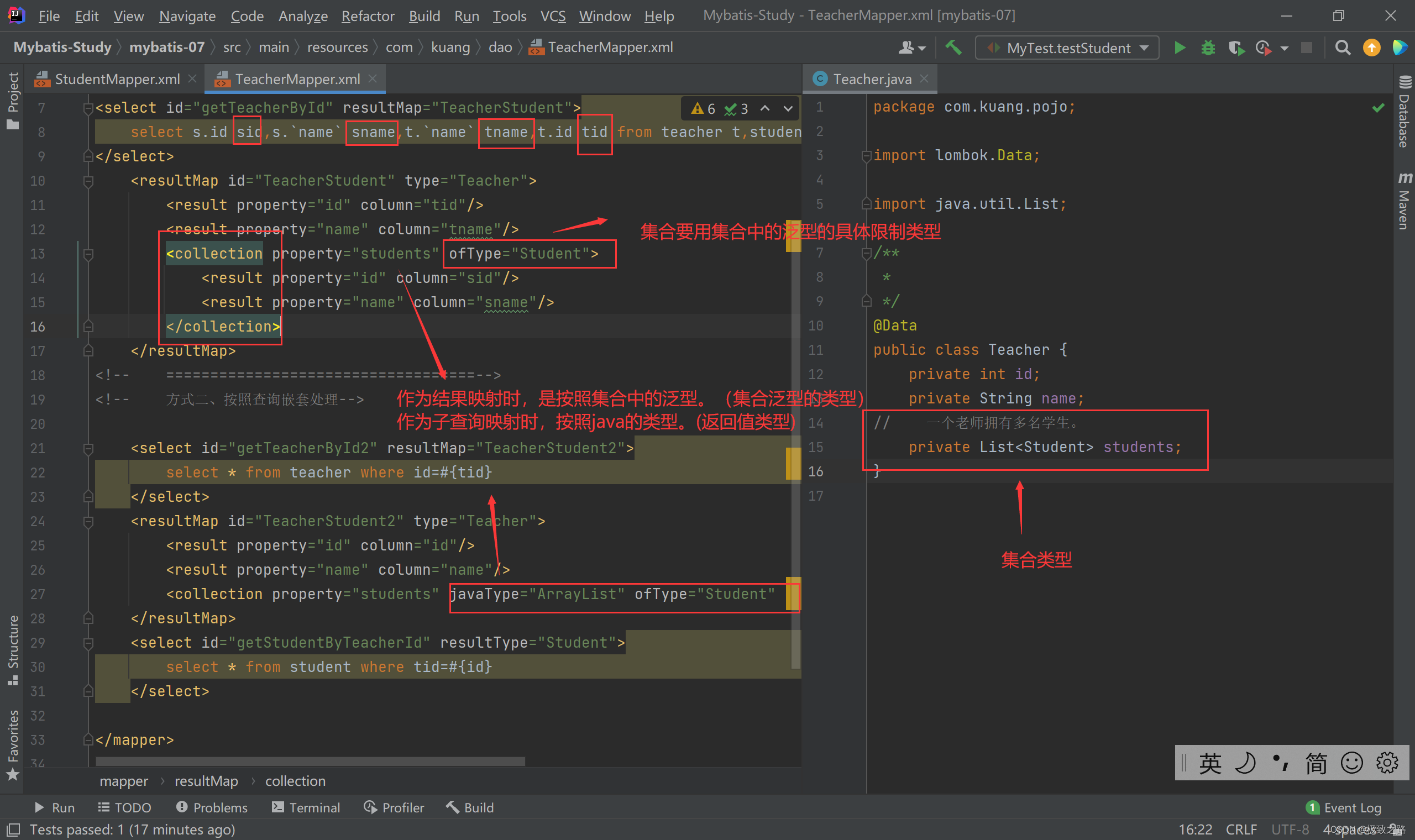
collection映射集合
2.方式二、按照查询嵌套处理
<select id="getTeacherById2" resultMap="TeacherStudent2">
select * from teacher where id=#{tid}
</select>
<resultMap id="TeacherStudent2" type="Teacher">
<result property="id" column="id"/>
<result property="name" column="name"/>
<collection property="students" javaType="ArrayList" ofType="Student" column="id" select="getStudentByTeacherId"/>
</resultMap>
<select id="getStudentByTeacherId" resultType="Student">
select * from student where tid=#{id}
</select>
(3)建立Mapper.xml文件的步骤
1.创建一个实体类对应的xml文件
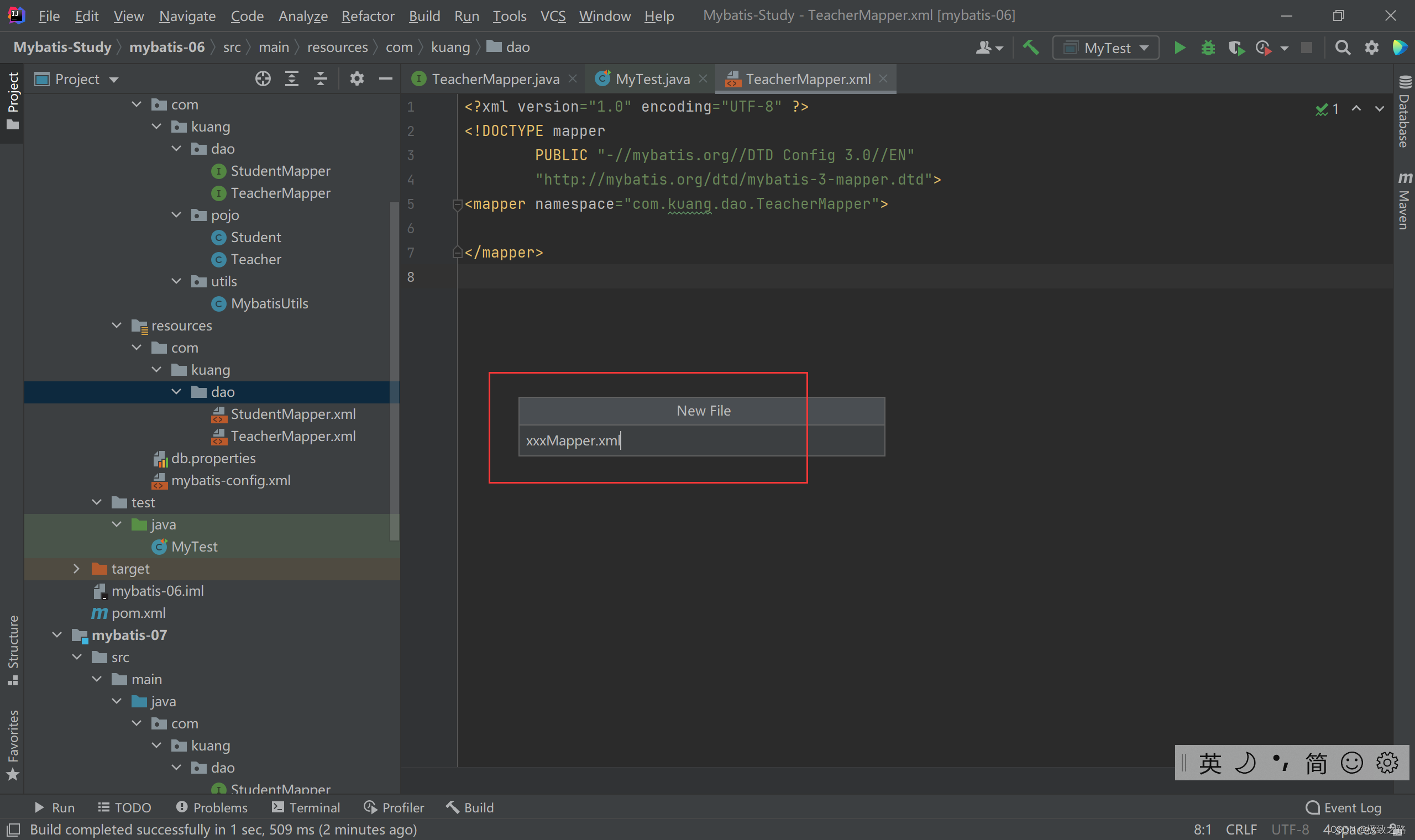
2.复制mybatis核心配置文件mybatis-config.xml到该文件中,并只保留头部

3.更改config为mapper
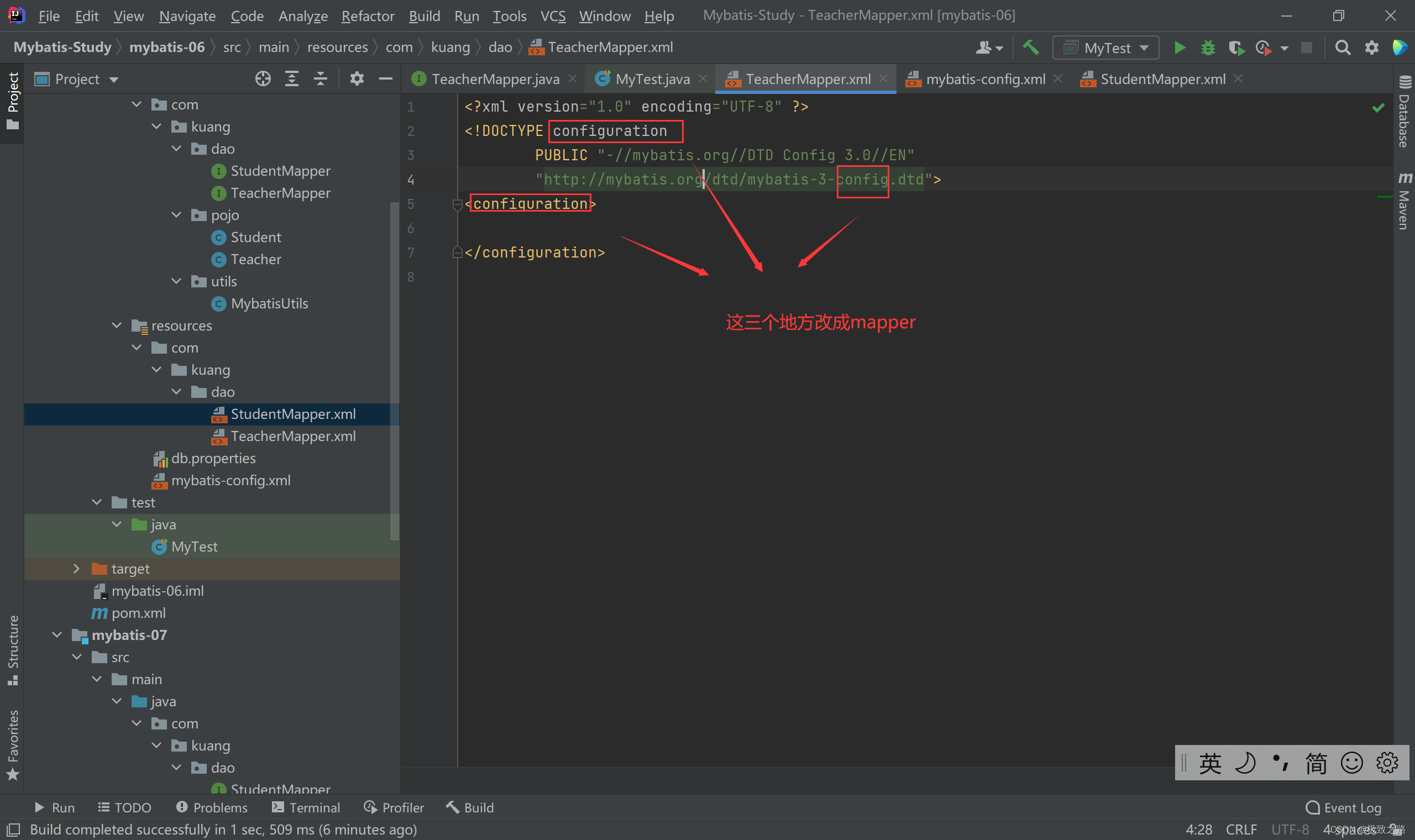
4.如图
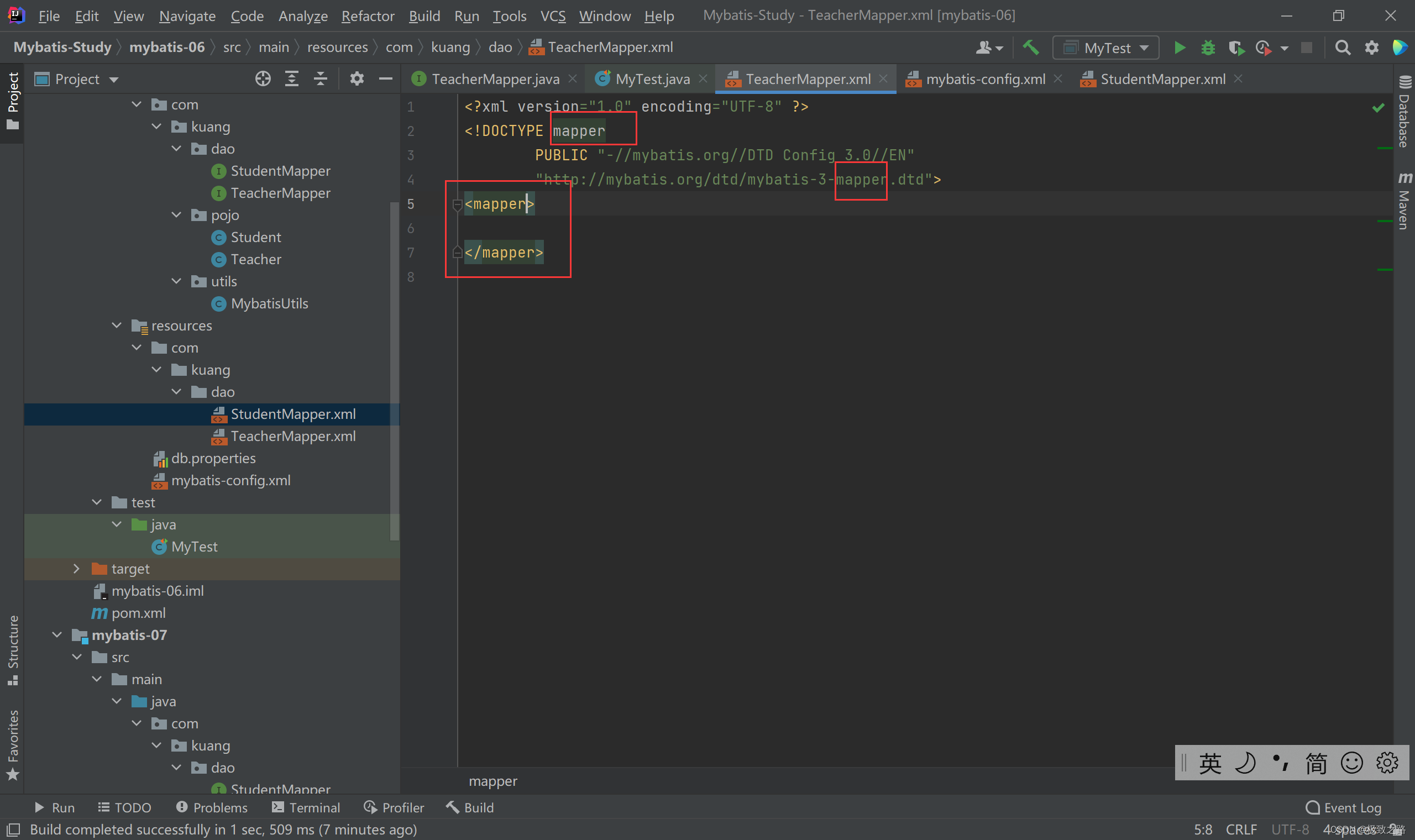
十一、动态SQL
什么是动态SQL:动态SQL就是根据不同的条件生成不同的SQL语句。
动态sql的使用和jstl标签相似
如果你之前用过 JSTL 或任何基于类 XML 语言的文本处理器,你对动态 SQL 元素可能会感觉似曾相识。在 MyBatis 之前的版本中,需要花时间了解大量的元素。借助功能强大的基于 OGNL 的表达式,MyBatis 3 替换了之前的大部分元素,大大精简了元素种类,现在要学习的元素种类比原来的一半还要少。
动态sql相关的标签:
- if
- choose (when, otherwise)
- trim (where, set)
- foreach
(1)环境搭建
1.实例表
CREATE TABLE `blog`(
`id` VARCHAR(50) NOT NULL COMMENT '博客id',
`title` VARCHAR(100) NOT NULL COMMENT '博客标题',
`author` VARCHAR(30) NOT NULL COMMENT '博客作者',
`create_time` DATETIME NOT NULL COMMENT '创建时间',
`views` INT(30) NOT NULL COMMENT '浏览量'
)ENGINE=INNODB DEFAULT CHARSET=utf8
2.创建一个基础工程
导包、配置文件、实体类、工具类、实体类对应的Mapper接口和Mapper.xml文件、测试。
2.1工具类IDutils :
public class IDutils {
public static String getId() {
return UUID.randomUUID().toString().replace("-","");
}
@Test
public void test() {
System.out.println(IDutils.getId());
System.out.println(IDutils.getId());
System.out.println(IDutils.getId());
}
}
2.2 驼峰命名
<setting name="mapUnderscoreToCamelCase" value="true"/>
(2)IF标签
需求:查询某个title就传某个title,查询某个author就传某个author,什么都没传就查询所有。
接口:
//查询博客
List<Blog> queryBlogIf(Map map);
xml文件:
<select id="queryBlogIf" parameterType="map" resultType="blog">
select * from blog where 1=1
<if test="title !=null">
and title=#{title}
</if>
<if test="author!=null">
and author =#{author}
</if>
</select>
测试:
@Test
public void queryBlogIf() {
SqlSession sqlSession = MybatisUtils.getSqlSession();
BlogMapper mapper = sqlSession.getMapper(BlogMapper.class);
HashMap<String, String> map = new HashMap<String, String>();
map.put("title","Spring如此简单");
map.put("author", "狂神说");
List<Blog> blogs = mapper.queryBlogIf(map);
for (Blog blog : blogs) {
System.out.println(blog);
}
sqlSession.close();
}
- if标签可对传入的值进行条件判断。
- 这里的where 1=1是不正规的。
- 这样sql语句没有变,可以通过不同的参数实现一个动态的效果。

官方文档上的东西不易于理解,这些东西的学习方式是把它的一些东西剖析成自己的一些东西。
(3)choose、when、otherwise组合
如果现在需求又变了,title、views和author只查其中一个。

接口:
List<Blog> queryBlogChoose(Map map);
xml文件:
<select id="queryBlogChoose" parameterType="map" resultType="blog">
select * from blog
<where>
<choose>
<when test="author!=null">
author=#{author}
</when>
<when test="title!=null">
title=#{title}
</when>
<otherwise>
views=#{views}
</otherwise>
</choose>
</where>
</select>
测试:
@Test
public void queryBlogChoose() {
SqlSession sqlSession = MybatisUtils.getSqlSession();
BlogMapper mapper = sqlSession.getMapper(BlogMapper.class);
HashMap<String, Object> map = new HashMap<String, Object>();
map.put("author","狂神说");
map.put("title","微服务如此简单");
map.put("views",1000);
List<Blog> blogs = mapper.queryBlogChoose(map);
for (Blog blog : blogs) {
System.out.println(blog);
}
sqlSession.close();
}
类似于switch,case 当满足条件时,就匹配对应的语句,且只匹配1个case。
(4)trim(where、set)
where和set有个总的标签叫trim,但一般不用总的标签。
4.1 where


<select id="queryBlogIf" parameterType="map" resultType="blog">
select * from blog where 1=1
<if test="title !=null">
and title = #{title}
</if>
<if test="author!=null">
and author = #{author}
</if>
</select>
更改这个sql语句为:
<select id="queryBlogIf" parameterType="map" resultType="blog">
select * from blog
<where>
<if test="title !=null">
title = #{title}
</if>
<if test="author!=null">
and author = #{author}
</if>
</where>
</select>
- where用标签替换后,开头多余的and或or会自动去除。
- 如果什么都不传,where标签也会自动去除。
4.2 set
set类似于where,会自动删除后面的逗号。

接口:
// 更新博客
int updateBlog(Map map);
xml文件:
<update id="updateBlog" parameterType="map">
update blog
<set>
<if test="title!=null">
title = #{title},
</if>
<if test="author!=null">
author=#{author}
</if>
</set>
where id =#{id}
</update>
测试:
@Test
public void updateBlog() {
SqlSession sqlSession = MybatisUtils.getSqlSession();
BlogMapper mapper = sqlSession.getMapper(BlogMapper.class);
HashMap<String, Object> map = new HashMap<String, Object>();
// map.put("author","狂神说333");
map.put("title","微服务如此简单3334");
map.put("id","459863eb5c4a4e5e929a5beb8c27afec");
mapper.updateBlog(map);
sqlSession.commit();
sqlSession.close();
}
4.3 trim
一般where和set就够用了,很少再用这个定制化。


所谓动态SQL,本质还是SQL语句,只是我们可以在SQL层面去执行一个逻辑代码
(5)SQL片段
- 使用sql标签抽取公共部分
- 在需要使用的地方使用include标签引用即可
<!-- sql代码片段-->
<sql id="if-title-author">
<if test="title !=null">
and title=#{title}
</if>
<if test="author!=null">
and author=#{author}
</if>
</sql>
<select id="queryBlogIfSql" parameterType="map" resultType="blog">
select * from blog
<where>
<include refid="if-title-author"></include>
</where>
</select>
注意事项:
- 最好基于单表来定义sql片段。
- 不要在SQL片段中使用where标签。
sql语句里面不要做一些太复制的事情,复杂的事情重用的效率就变低了。 因此包含的时候尽量只要一些if判断就好了。
(6)foreach标签
现在要查一些特殊的查询。比如只查表中的123号人。
例如要查这个语句:
select * from blog where 1=1 and (id=1 or id=2 or id=3);
Id=1 or id=2 or id=3在动态sql里面只能通过foreach。
接口:
//foreach
List<Blog> queryBolgForeach(Map map);
xml文件:
<!-- foreach-->
<select id="queryBolgForeach" parameterType="map" resultType="blog">
select * from blog
<where>
<foreach collection="ids" item="id" open="(" close=")" separator="or">
id=#{id}
</foreach>
</where>
</select>
map中put一个集合传参,作为foreach中的集合ids。
索引index一般用不到。
测试:
@Test
public void queryBolgForeach(){
SqlSession sqlSession = MybatisUtils.getSqlSession();
BlogMapper mapper = sqlSession.getMapper(BlogMapper.class);
HashMap map = new HashMap();
ArrayList<Integer> ids = new ArrayList<Integer>();
ids.add(1);
ids.add(2);
ids.add(3);
map.put("ids",ids);
List<Blog> blogs = mapper.queryBolgForeach(map);
for (Blog blog : blogs) {
System.out.println(blog);
}
sqlSession.close();
}
- 你可以将任何可迭代对象(如 List、Set 等)、Map 对象或者数组对象作为集合参数传递给 foreach。
- 当使用可迭代对象或者数组时,index 是当前迭代的序号,item 的值是本次迭代获取到的元素。
- 当使用 Map 对象(或者 Map.Entry 对象的集合)时,index 是键,item 是值。
动态SQL就是在拼接SQL语句,我们只要保证SQL的正确性,按照SQL的格式,去排列组合就可以了
- 可以先在Mysql中写出完整的SQL语句,语法正确后,再对应去修改成动态SQL实现通用即可。
十二、缓存(了解)
(1)简介
1.什么是缓存?
- 存在内存中的临时数据
- 将用户经常查询的数据放在缓存(内存)中,用户去查询数据就不用了从磁盘上(关系型数据库数据文件)查询,从缓存中查询,从而提高查询效率,解决了高并发系统的性能问题。
2.为什么使用缓存?
- 减少和数据库的交互次数,较少系统开销,提高系统效率。
3.什么样的数据能使用缓存?
- 经常查询而且不经常改变的数据。
(2)MyBatis缓存
-
MyBatis包含一个非常强大的查询缓存特性,它可以非常方便地定制和配置缓存。缓存可以极大的提升查询效率。
-
MyBatis系统中默认定义了两级缓存:一级缓存和二级缓存。
- 默认情况下,只有一级缓存开启。(SqlSession级别的缓存,也称为本地缓存)
- 二级缓存需要手动开启和配置,他是基于namespace级别的缓存。
- 为了提高扩展性,MyBatis定义了缓存接口Cache。我们可以通过实现Cache接口来自定义二级缓存。

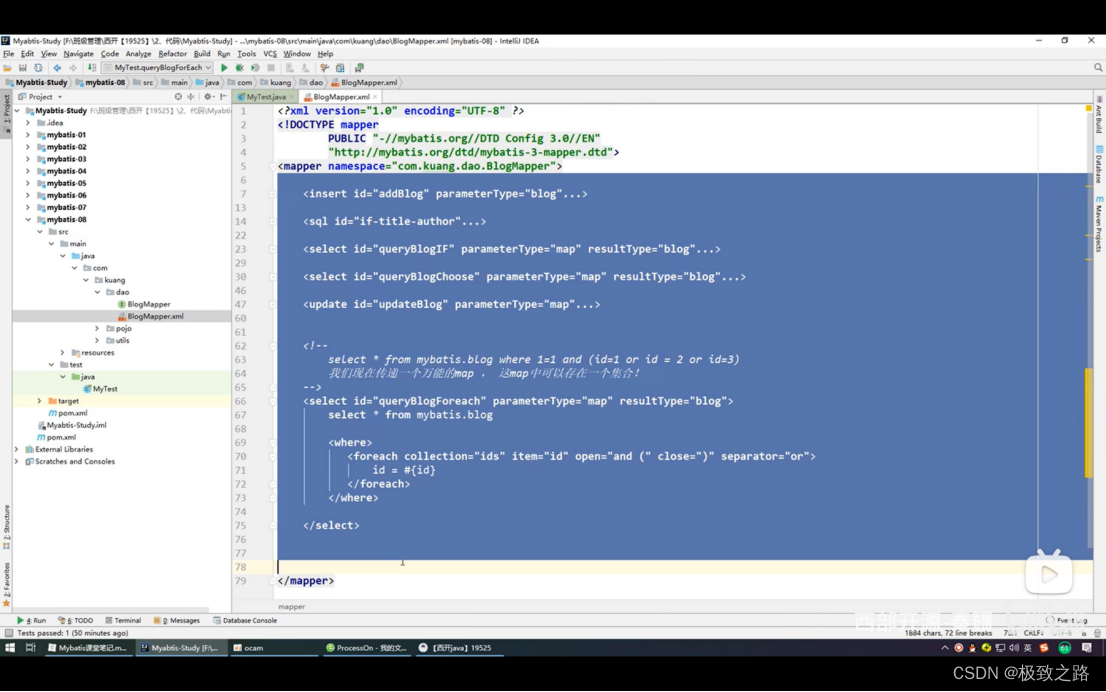
-
sqlSession级别:一个SqlSession从获取到关闭的过程。
-
namespace级别:一个mapper接口中的所有的SqlSession。
(3)一级缓存
- 一级缓存也叫本地缓存:
- 与数据库同一次会话期间查询到的数据会放在本地缓存中。
- 以后如果需要获取相同的数据,直接从缓存中拿,没必须再去查询数据库;
测试步骤:
- 开启日志
- 测试在Session中查询两次相同的记录
@Test
public void test(){
SqlSession sqlSession = MybatisUtils.getSqlSession();
UserMapper mapper = sqlSession.getMapper(UserMapper.class);
User user = mapper.queryUserById(1);
System.out.println(user);
System.out.println("=================================================================");
User user2 = mapper.queryUserById(1);
System.out.println(user2);
System.out.println(user==user2);
sqlSession.close();
}
- 查看日志输出

- 缓存失效
- 1.查询不同的东西。(方法)
- 2.增删改操作,可能会改变原来的数据,所以必定会刷新缓存。
- 3.查询不同的Mapper.xml。
- 4.手动清理缓存。
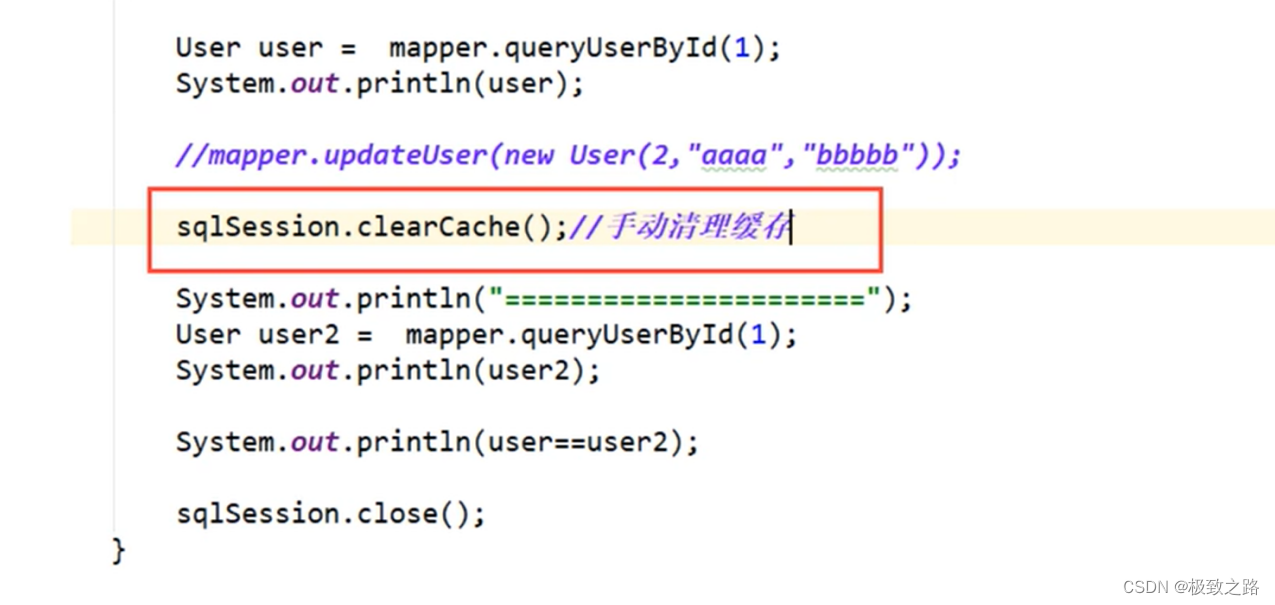
一级缓存只有在连续查询相同的一个时,才有点用。比如说用户不停的在刷新一个页面,不停的查询时。
小结:一级缓存默认是开启的,只在一次SqlSession中有效,也就是拿到连接到关闭连接这个区间段(相当于一个用户不断查询相同的数据,比如不断刷新),一级缓存就是一个map。
(4)二级缓存
- 二级缓存也叫全局缓存,一级缓存作用域太低了,所以诞生了二级缓存。
- 基于namespace级别的缓存,一个名称空间(接口),对应一个二级缓存。
- 工作机制
- 一个会话(用户)查询一条数据,这个数据就会被放在当前会话的一级缓存中。
- 如果当前会话关闭了,这个会话对应的一级缓存就没了;但是我们想要的是,会话关闭了,一级缓存中的数据被保存到二级缓存中。
- 新的会话查询信息,就可以从二级缓存中获取内容。
- 不同的mapper查出的数据会放在自己对应的缓存(map)中。
步骤
1.开启全局缓存(settings)
在mybatis核心配置文件mybatis-config.xml中设置:
<!-- 显示的开启全局缓存-->
<setting name="cacheEnable" value="true"/>
2.在要使用二级缓存的Mapper中开启
<cache/>
可以不加参数,也可以自定义参数:
<!-- 在当前Mapper.xml中使用二级缓存-->
<cache eviction="FIFO"
flushInterval="60000"
size="512"
readOnly="true"/>
3.测试
@Test
public void test(){
SqlSession sqlSession = MybatisUtils.getSqlSession();
SqlSession sqlSession2 = MybatisUtils.getSqlSession();
UserMapper mapper = sqlSession.getMapper(UserMapper.class);
User user = mapper.queryUserById(1);
System.out.println(user);
sqlSession.close();
UserMapper mapper2 = sqlSession2.getMapper(UserMapper.class);
User user2 = mapper.queryUserById(1);
System.out.println(user2);
sqlSession2.close();
System.out.println(user==user2);
}
4.结果
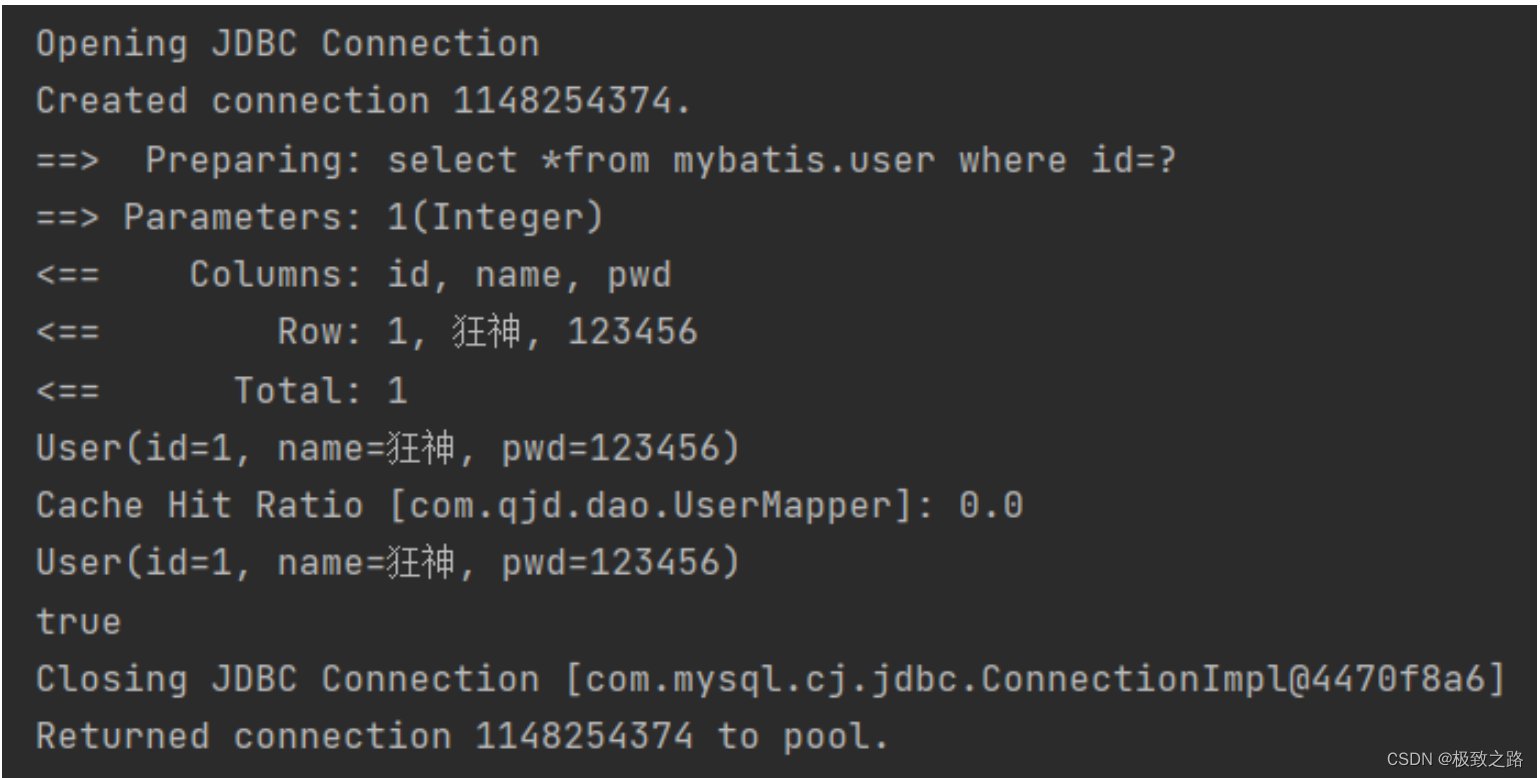
可以看到只运行一次sql
单个查询中也可以使用缓存,增删改也可以设置不刷新缓存:
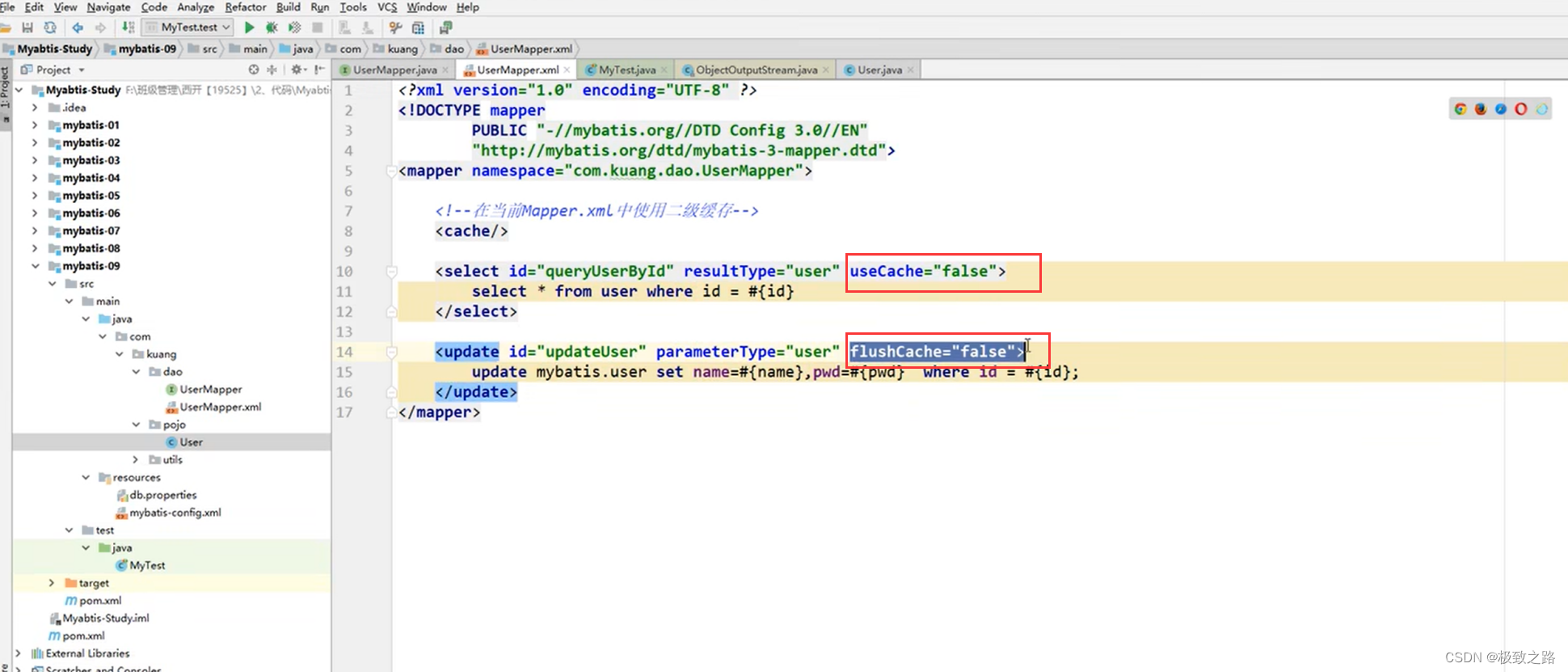
问题:
- 1.我们需要将实体类序列化(实现Serializable接口),否则就会报错
- 2.sqlsession关闭的时候一定要在最后关闭,不能先关闭sqlsession再关闭sqlsession2,这样会导致Cause:
org.apache.ibatis.executor.ExecutorException: Executor was closed
4.小结
- 只要开启了二级缓存,在同一个Mapper下就有效。
- 所有的数据都会先放在一级缓存中。
- 只有当会话提交,或者关闭的时候才会提交到二级缓存中。
(5)Mybatis缓存原理
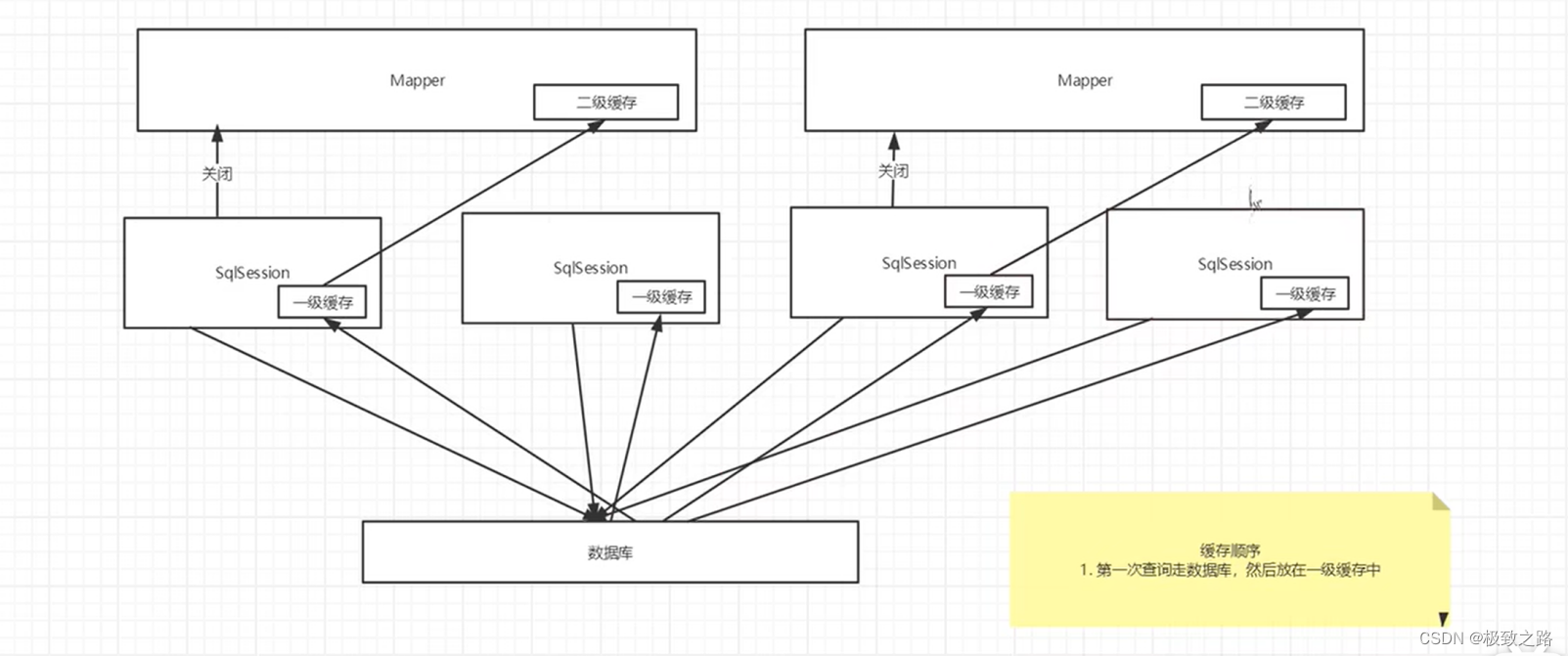
1.程序中:
- 第一次查询走数据库,当第一次查询完结果放到一级缓存中,第二次就走一级缓存了。
- 当每一个sqlSession关闭的时候,对应一级缓存中的东西就会转移到对应Mapper的二级缓存中。
2.用户访问时,正确的顺序应该是:
- 1.先看二级缓存中有没有
- 2.再看一级缓存中有没有
- 3.查询数据库
(6)自定义缓存
介绍:
- EhCache 是一个纯Java的进程内缓存框架,具有快速、精干等特点,是Hibernate中默认的CacheProvider。
- Ehcache是一种广泛使用的开源Java分布式缓存。主要面向通用缓存。
1.要在程序中使用ehcache,先要导包:
<dependency>
<groupId>org.mybatis.caches</groupId>
<artifactId>mybatis-ehcache</artifactId>
<version>1.1.0</version>
</dependency>
2.在mapper中指定使用我们的ehcache缓存实现:
<cache type="org.mybatis.caches.ehcache.EhcacheCache"/>
这部分关于缓存的内容了解就可以,以后开发我们会用Redis数据库来做缓存!
十三、错误总结
























 132
132











 被折叠的 条评论
为什么被折叠?
被折叠的 条评论
为什么被折叠?








